Opel Omega 1994 1999 User Manual
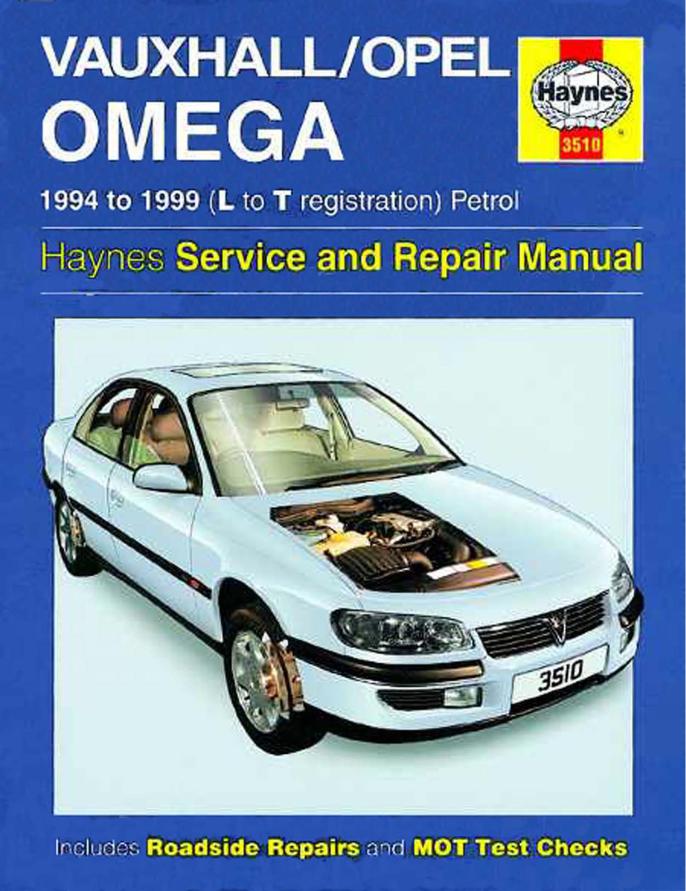
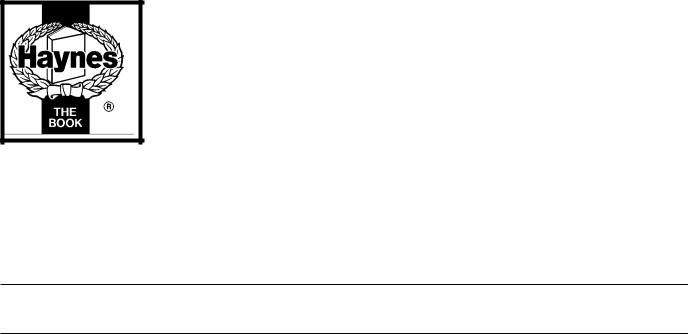
Vauxhall/Opel Omega
Service and Repair Manual
Mark Coombs and Spencer Drayton
Models covered |
(3510 - 352) |
Vauxhall Omega Saloon and Estate models with petrol engines, including special/limited editions 1998 cc, 2498 cc & 2969 cc petrol engines
Does not cover diesel engine or bi-fuel (LPG) models
© Haynes Publishing 1999 |
ABCDE |
|
|
FGHIJ |
|
|
KLMNO |
|
A book in the Haynes Service and Repair Manual Series |
PQRST |
|
1 2 3 |
||
|
All rights reserved. No part of this book may be reproduced or transmitted in any form or by any means, electronic or mechanical, including photocopying, recording or by any information storage or retrieval system, without permission in writing from the copyright holder.
ISBN 1 850960 510 9
British Library Cataloguing in Publication Data
A catalogue record for this book is available from the British Library.
Printed by J H Haynes & Co. Ltd, Sparkford, Nr Yeovil, Somerset BA22 7JJ
Haynes Publishing
Sparkford, Nr Yeovil, Somerset BA22 7JJ, England
Haynes North America, Inc
861 Lawrence Drive, Newbury Park, California 91320, USA
Editions Haynes S.A.
Tour Aurore - La Défense 2, 18 Place des Reflets, 92975 PARIS LA DEFENSE Cedex France
Haynes Publishing Nordiska AB
Box 1504, 751 45 UPPSALA, Sverige
3510 Vauxhall/Opel Omega

Contents
LIVING WITH YOUR VAUXHALL OMEGA
Introduction |
Page |
0•4 |
Safety First! |
Page |
0•5 |
|
|
|
Roadside Repairs
Introduction |
Page |
0•6 |
If your car won’t start |
Page |
0•6 |
|
|
|
Jump starting |
Page |
0•7 |
|
|
|
Wheel changing |
Page |
0•8 |
|
|
|
Identifying leaks |
Page |
0•9 |
|
|
|
Towing |
Page |
0•9 |
|
|
|
Weekly Checks
Introduction |
Page |
0•10 |
Underbonnet check points |
Page |
0•10 |
|
|
|
Engine oil level |
Page |
0•11 |
|
|
|
Coolant level |
Page |
0•11 |
|
|
|
Brake (and clutch) fluid level |
Page |
0•12 |
|
|
|
Power steering fluid level |
Page |
0•12 |
|
|
|
Battery |
Page |
0•13 |
|
|
|
Electrical systems |
Page |
0•13 |
|
|
|
Tyre condition and pressure |
Page |
0•14 |
|
|
|
Tyre tread wear patterns |
Page |
0•14 |
|
|
|
Washer fluid level |
Page |
0•15 |
|
|
|
Wiper blades |
Page |
0•15 |
|
|
|
Lubricants and fluids |
Page |
0•16 |
|
|
|
Tyre pressures |
Page |
0•17 |
|
|
|
MAINTENANCE
Routine Maintenance and Servicing
Servicing specifications |
Page |
1•2 |
Maintenance schedule |
Page |
1•3 |
|
|
|
Maintenance procedures |
Page |
1•6 |
|
|
|
3510 Vauxhall/Opel Omega

Contents
REPAIRS & OVERHAUL
Engine and Associated Systems
2.0 litre SOHC engine in-car repair procedures |
Page |
2A•1 |
2.0 litre DOHC engine in-car repair procedures |
Page |
2B•1 |
|
|
|
2.5 and 3.0 litre engine in-car repair procedures |
Page |
2C•1 |
|
|
|
General engine overhaul procedures |
Page |
2D•1 |
|
|
|
Cooling, heating and ventilation systems |
Page |
3•1 |
|
|
|
Fuel and exhaust systems |
Page |
4A•1 |
|
|
|
Emission control systems |
Page |
4B•1 |
|
|
|
Starting and charging systems |
Page |
5A•1 |
|
|
|
Ignition system |
Page |
5B•1 |
|
|
|
Transmission
Clutch |
Page |
6•1 |
Manual transmission |
Page |
7A•1 |
|
|
|
Automatic transmission |
Page |
7B•1 |
|
|
|
Final drive, driveshafts and propeller shaft |
Page |
8•1 |
|
|
|
Brakes and Suspension
Braking system |
Page |
9•1 |
Suspension and steering |
Page |
10•1 |
|
|
|
Body equipment
Bodywork and fittings |
Page |
11•1 |
Body electrical system |
Page |
12•1 |
|
|
|
Wiring Diagrams
Page 12•23
REFERENCE
Dimensions and weights |
Page |
REF•1 |
Conversion Factors |
Page |
REF•2 |
|
|
|
Buying Spare Parts and Vehicle Identification |
Page |
REF•3 |
|
|
|
General Repair Procedures |
Page |
REF•4 |
|
|
|
Jacking and vehicle support |
Page |
REF•5 |
|
|
|
Radio/cassette unit anti-theft system precaution |
Page |
REF•5 |
|
|
|
Tools and working facilities |
Page |
REF•6 |
|
|
|
MOT Test Checks |
Page |
REF•8 |
|
|
|
Fault Finding |
Page REF•12 |
|
|
|
|
Glossary of Technical Terms |
Page REF•20 |
|
|
|
|
Index
Page REF•24
3510 Vauxhall/Opel Omega
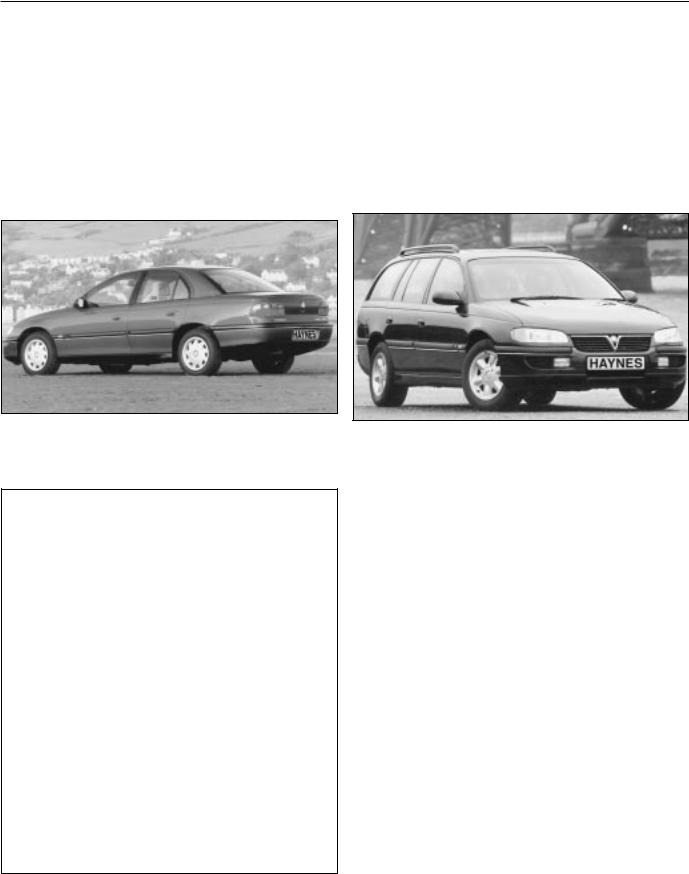
0•4 Introduction
The Vauxhall Omega was introduced into the UK in April of 1994 as a replacement for the Vauxhall Carlton and Senator. At its launch, the Omega was available in both Saloon and Estate body styles with a choice of either 2.0 litre (1998 cc) or a 2.5 litre (2498 cc) petrol engine both available with either a 5-speed manual transmission unit or a 4- speed automatic transmission unit. Shortly afterwards a 3.0 (2968 cc) litre petrol engine was also introduced. A 2.5 litre Diesel engine (not covered in this manual) was also available. The petrol engines are all well-proven units which are used in many other Vauxhall vehicles; the engine is mounted at the front of vehicle with the transmission mounted on its rear.
Two versions of the four-cylinder 2.0 litre engine were used; low specification vehicles were fitted with a single overhead camshaft (SOHC) 8-valve engine were as all other vehicles were fitted with the
double overhead camshaft (DOHC) 16-valve engine often referred to as the ECOTEC engine. The 2.5 and 3.0 litre engines are both V6, double overhead camshaft (DOHC) units which are also often referred as ECOTEC engines.
All models have fully-independent front and rear suspension and are equipped with front and rear disc brakes.
A wide range of standard and optional equipment is available within the range to suit most tastes, including central locking, electric windows and an electric sunroof. An air conditioning system was available as an option on certain models.
Provided that regular servicing is carried out in accordance with the manufacturer’s recommendations, the vehicle should prove reliable and very economical. The engine compartment is well-designed, and most of the items requiring frequent attention are easily accessible.
Vauxhall Omega 2.0 16V Select
Vauxhall Omega Estate CD
The Vauxhall Omega Team
Haynes manuals are produced by dedicated and enthusiastic people working in close co-operation. The team responsible for the creation of this book included:
Authors |
Marc Coombs |
|
Spencer Drayton |
Sub-editor |
Ian Barnes |
Editor & Page Make-up |
Steve Churchill |
Workshop manager |
Paul Buckland |
Photo Scans |
Steve Tanswell |
|
John Martin |
Cover illustration & Line Art |
Roger Healing |
Wiring diagrams |
Matthew Marke |
We hope the book will help you to get the maximum enjoyment from your car. By carrying out routine maintenance as described you will ensure your car’s reliability and preserve its resale value.
Your Vauxhall Omega manual
The aim of this manual is to help you get the best value from your vehicle. It can do so in several ways. It can help you decide what work must be done (even should you choose to get it done by a garage). It will also provide information on routine maintenance and servicing, and give a logical course of action and diagnosis when random faults occur. However, it is hoped that you will use the manual by tackling the work yourself. On simpler jobs it may even be quicker than booking the car into a garage and going there twice, to leave and collect it. Perhaps most important, a lot of money can be saved by avoiding the costs a garage must charge to cover its labour and overheads.
The manual has drawings and descriptions to show the function of the various components so that their layout can be understood. Tasks are described and photographed in a clear step-by-step sequence.
References to the ‘left’ and ‘right’ are in the sense of a person in the driver’s seat, facing forwards.
Acknowledgements
Thanks are due to Champion Spark Plug, who supplied the illustrations showing spark plug conditions. Certain illustrations are the copyright of Vauxhall Motors Limited, and are used with their permission. Thanks are also due to Draper Tools Limited, who provided some of the workshop tools, and to all those people at Sparkford who helped in the production of this manual.
We take great pride in the accuracy of information given in this manual, but vehicle manufacturers make alterations and design changes during the production run of a particular vehicle of which they do not inform us. No liability can be accepted by the authors or publishers for loss, damage or injury caused by any errors in, or omissions from, the information given.
3510 Vauxhall/Opel Omega

Safety first! 0•5
Working on your car can be dangerous. This page shows just some of the potential risks and hazards, with the aim of creating a safety-conscious attitude.
General hazards
Scalding
•Don’t remove the radiator or expansion tank cap while the engine is hot.
•Engine oil, automatic transmission fluid or power steering fluid may also be dangerously hot if the engine has recently been running.
Burning
• Beware of burns from the exhaust system and from any part of the engine. Brake discs and drums can also be extremely hot immediately after use.
Crushing
•When working a raised vehicle, always supplement the jack with axle stands, or use drive-on ramps.
Never venture under a car
is only supported
•Take care if torque nuts Initial loosening done with the
Fire
•Fuel is highly explosive.
•Don’t let fuel
•Do not smoke (including pilot vehicle being creating sparks (electrically or by
•Fuel vapour is work on the fuel an inspection pit
•Another cause overload or short repairing or
•Keep a fire suitable for use
Electric shock
• Ignition HT voltage can be dangerous, especially to people with heart problems or a pacemaker. Don’t work on or near ignition system the engine running
the ignition switched on.
• Mains voltage is also dangerous. Make sure that any mains-operated equipment is correctly earthed. Mains power points should be protected by a residual current device (RCD) circuit breaker.
Fume or gas intoxication
•Exhaust fumes are poisonous; they contain carbon monoxide, which is rapidly fatal if inhaled Never run the engine in a
confined space such as a garage with the doors shut
•Fuel vapour is also poisonous, as are cleaning solvents
your pocket.
• Air conditioning poisonous gas if (including a cigarette) burns on contact.
Asbestos
• Asbestos dust can or swallowed. gaskets and in brake When dealing with safest to assume
Special hazards
Hydrofluoric acid
• This extremely corrosive acid is formed when certain types of synthetic rubber, found in some O-rings, oil seals, fuel hoses etc, are exposed to temperatures above 4000C. The
changes into a charred or sticky containing the acid. Once formed,
remains dangerous for years. If it the skin, it may be necessary to the limb concerned.
dealing with a vehicle which has
a fire, or with components salvaged a vehicle, wear protective gloves
discard them after use.
battery
• Batteries contain sulphuric acid, which attacks clothing, eyes and skin. Take care
topping-up or carrying the battery. hydrogen gas given off by the battery
explosive. Never cause a spark or naked light nearby. Be careful when and disconnecting battery
or jump leads.
can cause injury if they go off
. Take care when removing the wheel and/or facia. Special storage
instructions may apply.
Diesel injection equipment
• Diesel injection pumps supply fuel at very high pressure. Take care when working on the fuel injectors and fuel pipes.
Warning: Never expose the hands, face or any other part of the body to injector spray; the fuel can
penetrate the skin with potentially fatal results.
Remember...
DO |
DON’T |
|
• Do use eye protection when using power |
• Don’t attempt to lift a heavy component |
|
tools, and when working under the vehicle. |
which may be beyond your capability – get |
|
• Do wear gloves or use barrier cream to |
assistance. |
|
• Don’t rush to finish a job, or take |
||
protect your hands when necessary. |
||
• Do get someone to check periodically |
unverified short cuts. |
|
• Don’t use ill-fitting tools which may slip |
||
that all is well when working alone on the |
||
vehicle. |
and cause injury. |
|
• Do keep loose clothing and long hair well |
• Don’t leave tools or parts lying around |
|
out of the way of moving mechanical parts. |
where someone can trip over them. Mop |
|
• Do remove rings, wristwatch etc, before |
up oil and fuel spills at once. |
|
• Don’t allow children or pets to play in or |
||
working on the vehicle – especially the |
||
electrical system. |
near a vehicle being worked on. |
|
• Do ensure that any lifting or jacking |
|
|
equipment has a safe working load rating |
|
|
adequate for the job. |
|
3510 Vauxhall/Opel Omega
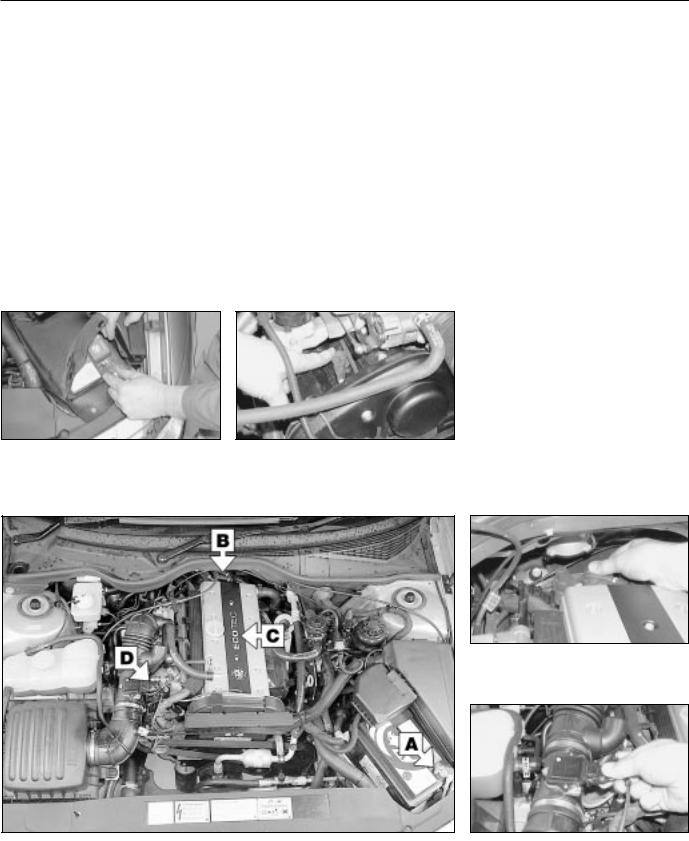
0•6 Roadside repairs
The following pages are intended to help in dealing with common roadside emergencies and breakdowns. You will find more detailed fault finding information at the back of the manual, and repair information in the main chapters.
If your car won’t start and the starter motor doesn’t turn
If your car won’t start even though the starter motor turns as normal
MIf it’s a model with automatic transmission, make sure the selector is in ‘P’ or ‘N’.
MOpen the bonnet and make sure that the battery terminals are clean and tight.
MSwitch on the headlights and try to start the engine. If the headlights go very dim when you’re trying to start, the battery is probably flat. Get out of trouble by jump starting (see next page) using a friend’s car.
MIs there fuel in the tank?
MIs there moisture on electrical components under the bonnet? Switch off the ignition, then wipe off any obvious dampness with a dry cloth. Spray a water-repellent aerosol product (WD-40 or equivalent) on ignition and fuel system electrical connectors like those shown in the photos.
Pay special attention to the ignition coil wiring connector and HT leads.
A Check the condition and security of the battery connections
B Check that the spark plug HT leads are securely connected by pushing them onto the plugs (where accessible)
C Check that the spark plug HT leads are securely connected by pushing them onto the DIS module (where accessible)
Check that electrical connections are secure (with the ignition switched off) and spray them with a water dispersant spray like WD40 if you suspect a problem due to damp
D Check that the engine management system wiring connectors are securely connected
3510 Vauxhall/Opel Omega
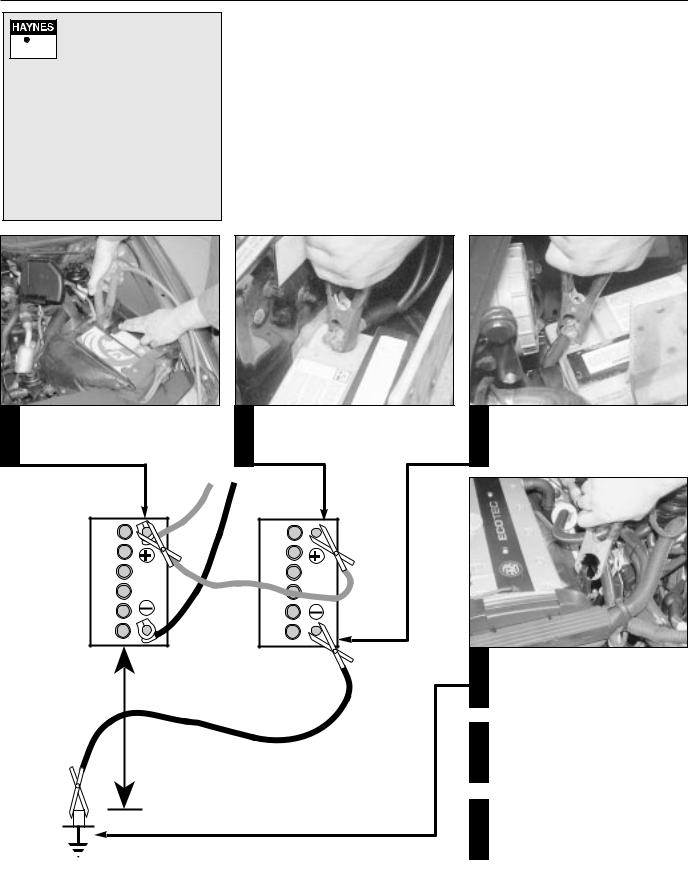
Roadside repairs 0•7
Jump starting will get you out of trouble, but you must correct


 whatever made the battery go flat in the first place. There are three possibilities:
whatever made the battery go flat in the first place. There are three possibilities:
1The battery has been drained by repeated attempts to start, or by
leaving the lights on.
2The charging system is not working properly (alternator drivebelt slack
or broken, alternator wiring fault or alternator itself faulty).
3The battery itself is at fault (electrolyte low, or battery worn out).
1 Connect one end of the red jump lead to the positive (+) terminal of the flat battery
When jump-starting a car using a booster battery, observe the following precautions:
Before connecting the booster battery, make sure that the ignition is switched off.
Ensure that all electrical equipment (lights, heater, wipers, etc) is switched off.
Take note of any special precautions printed on the battery case.
Jump starting
Make sure that the booster battery is the same voltage as the discharged one in the vehicle.
If the battery is being jump-started from the battery in another vehicle, the two vehicles MUST NOT TOUCH each other.
Make sure that the transmission is in neutral (or PARK, in the case of automatic transmission).
2 Connect the other end of the red lead to the positive (+) terminal of the booster battery.
3 Connect one end of the black jump lead to the negative (-) terminal of the booster battery
4 Connect the other end of the black jump lead to a bolt or bracket on the engine block, well away from the battery, on the vehicle to be started.
Make sure that the jump leads will not 5 come into contact with the fan, drive-
belts or other moving parts of the engine.
Start the engine using the booster
6 battery and run it at idle speed. Switch on the lights, rear window demister and heater blower motor, then disconnect the jump leads in the reverse order of connection. Turn off the lights etc.
3510 Vauxhall/Opel Omega
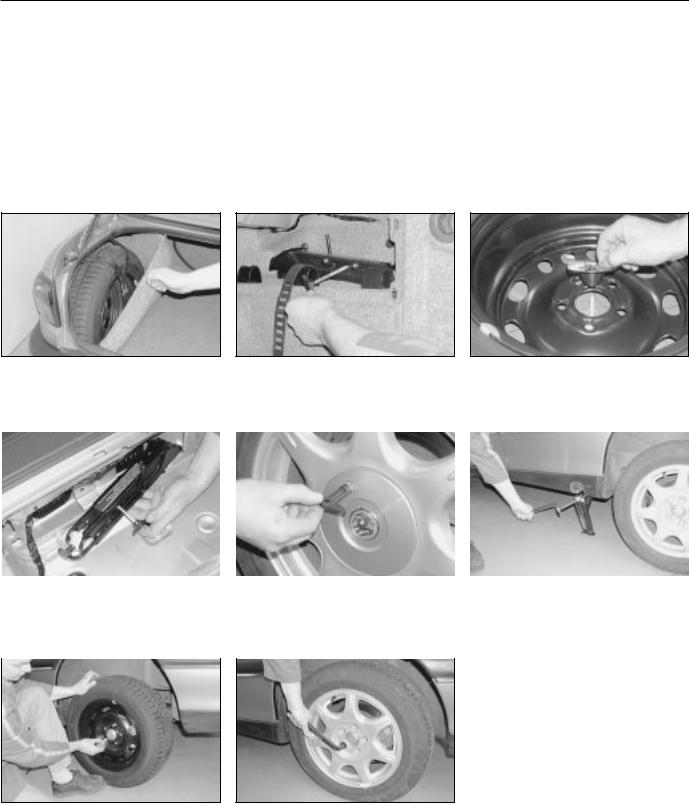
0•8 Roadside repairs
Wheel changing
Some of the details shown here will vary according to model.
Warning: Do not change a wheel in a situation where you risk being hit by another vehicle. On busy roads, try to stop in a lay-by or a gateway. Be wary of passing traffic while changing the wheel - it is easy to become distracted by the job in hand.
Preparation
MWhen a puncture occurs, stop as soon as it is safe to do so.
MPark on firm level ground, if possible, and well out of the way of other traffic.
MUse hazard warning lights if necessary.
Changing the wheel
MIf you have one, use a warning triangle to alert other drivers of your presence.
MApply the handbrake and engage first or reverse gear (or Park on models with automatic transmission.
MChock the wheel diagonally opposite the one being removed – a couple of large stones will do for this.
MIf the ground is soft, use a flat piece of wood to spread the load under the jack.
1 |
On Saloon models unclip the luggage |
2 |
. . . The tools and jack are stored in the |
3 |
On Estate models lift up the luggage |
||
compartment left-hand trim panel then |
smaller compartment on the right-hand |
compartment floor panel and remove the |
|||||
|
release the retaining strap and remove |
|
side of the luggage compartment. Remove |
|
tools from the centre of the spare wheel. |
||
the |
spare wheel . . . |
the |
cover (where fitted) then unscrew the bolt |
Undo |
the retaining nut and remove the spare |
||
|
|
|
and remove the jack and wheelbrace. |
wheel . . . |
|||
|
|
|
|
|
|
|
|
|
|
|
|
|
|
|
|
4 |
. . . then unscrew the retaining bolt and |
5 |
On models with steel wheels, use the |
6 |
Unclip the access cover from the sill trim |
||
remove the jack from behind the wheel. |
removal tool supplied to pull off the wheel |
panel then make sure the jack is located |
|||||
|
|
|
|
trim and on models with alloy wheels, use |
|
on firm ground and engage the jack head |
|
|
|
|
the |
tool supplied to unscrew the anti-theft bolt |
correctly with the lifting point on the sill. Make |
||
|
|
|
and remove the hub cap. Slacken each wheel |
sure that the lug on the jack head is correctly |
|||
|
|
|
bolt by half a turn. |
located in the sill seam cutout and the base of |
|||
|
|
|
|
|
|
the jack is directly underneath the sill seam. |
|
|
|
|
|
|
|
||
7 |
Raise the jack until the wheel is raised |
8 |
Securely tighten the wheel bolts in a |
clear of the ground. Unscrew the wheel |
diagonal sequence then refit the hub |
||
|
bolts and remove the wheel. Fit the spare |
|
cap/wheel trim (as applicable). Note that |
wheel and screw on the bolts. Lightly tighten |
the |
wheel bolts should be slackened and |
|
the bolts with the wheelbrace then lower the |
retightened to the specified torque at the |
||
vehicle to the ground. |
earliest possible opportunity. |
||
Finally...
MRemove the wheel chocks.
MStow the punctured wheel, jack and tools in the correct locations in the car.
MCheck the tyre pressure on the wheel just fitted. If it is low, or if you don’t have a pressure gauge with you, drive slowly to the nearest garage and inflate the tyre to the right pressure.
MHave the damaged tyre or wheel repaired as soon as possible.
3510 Vauxhall/Opel Omega
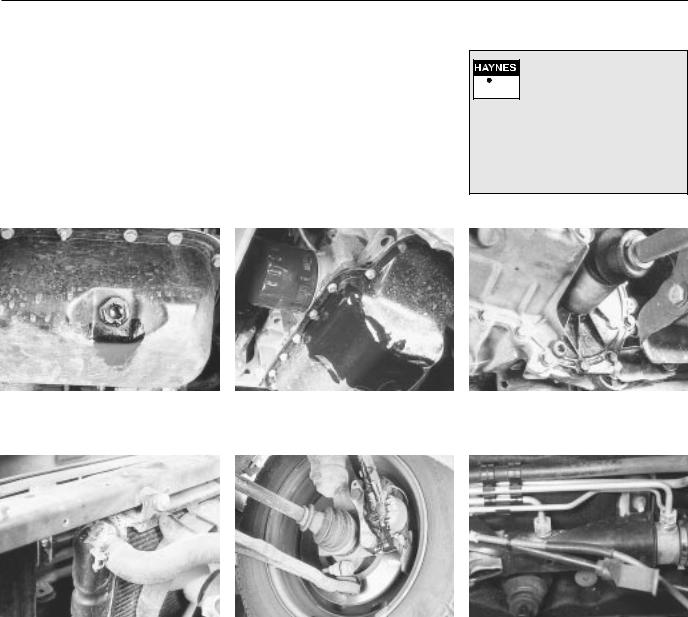
Roadside repairs 0•9
Puddles on the garage floor or drive, or obvious wetness under the bonnet or underneath the car, suggest a leak that needs investigating. It can sometimes be difficult to decide where the leak is coming from, especially if the engine bay is very dirty already. Leaking oil or fluid can also be blown rearwards by the passage of air under the car, giving a false impression of where the problem lies.
Warning: Most automotive oils and fluids are poisonous. Wash them off skin, and change out of contaminated clothing, without delay.
Identifying leaks
The smell of a fluid leaking from the car may provide a 

 clue to what’s leaking. Some fluids are distictively coloured.
clue to what’s leaking. Some fluids are distictively coloured.
It may help to clean the car carefully and to park it over some clean paper overnight as an aid to locating the source of the leak.
Remember that some leaks may only occur while the engine is running.
Sump oil |
|
Oil from filter |
|
Gearbox oil |
|
|
|
|
|
Engine oil may leak from the drain plug... |
...or from the base of the oil filter. |
Gearbox oil can leak from the seals at the inboard ends of the driveshafts.
Antifreeze |
|
Brake fluid |
|
Power steering fluid |
|
|
|
|
|
Leaking antifreeze often leaves a crystalline deposit like this.
A leak occurring at a wheel is almost certainly brake fluid.
Power steering fluid may leak from the pipe connectors on the steering rack.
When all else fails, you may find yourself having to get a tow home – or of course you may be helping somebody else. Long-distance recovery should only be done by a garage or breakdown service. For shorter distances, DIY towing using another car is easy enough, but observe the following points:
MUse a proper tow-rope – they are not expensive. The vehicle being towed must display an ‘ON TOW’ sign in its rear window.
MAlways turn the ignition key to the ‘on’ position when the vehicle is being towed, so
that the steering lock is released, and that the direction indicator and brake lights will work.
MBoth front and rear towing eyes are provided. They are located behind the access covers on the front and rear bumper.
MBefore being towed, release the handbrake and select neutral on the transmission.
MNote that greater-than-usual pedal pressure will be required to operate the brakes, since the vacuum servo unit is only operational with the engine running.
MOn models with power steering, greater-
Towing
than-usual steering effort will also be required.
MThe driver of the car being towed must keep the tow-rope taut at all times to avoid snatching.
MMake sure that both drivers know the route before setting off.
MOnly drive at moderate speeds and keep the distance towed to a minimum. Drive smoothly and allow plenty of time for slowing down at junctions.
MOn models with automatic transmission, special precautions apply. If in doubt, do not tow, or transmission damage may result.
3510 Vauxhall/Opel Omega
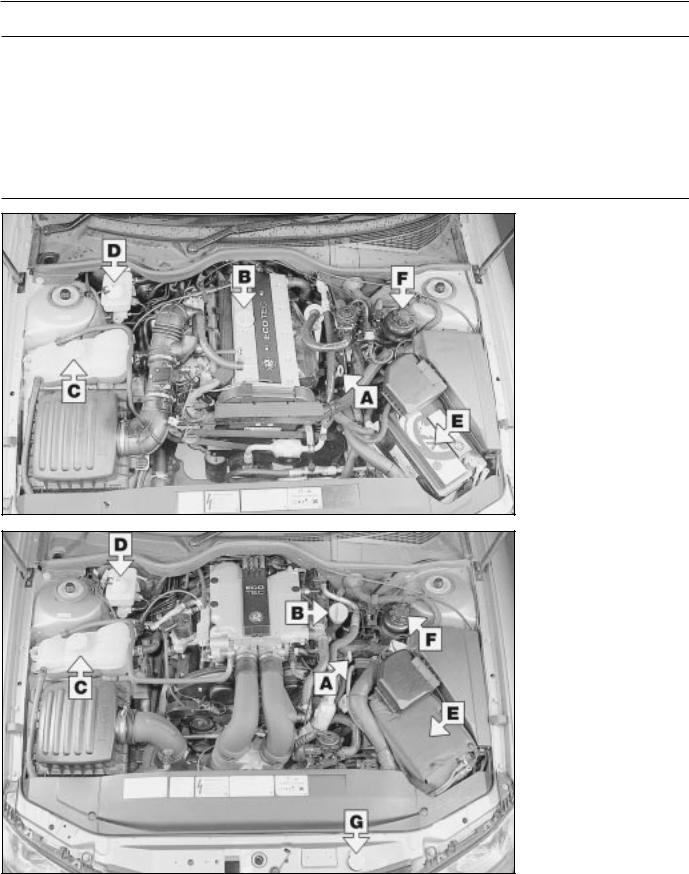
0•10 Weekly checks
Introduction
There are some very simple checks which need only take a few minutes to carry out, but which could save you a lot of inconvenience and expense.
M Keeping an eye on tyre condition and pressures, will not only help to stop them wearing out prematurely, but could also save your life.
M If your car develops a brake fluid leak, the first time you might know about it is when your brakes don't work properly. Checking the level regularly will give advance warning of this kind of problem.
These "Weekly checks" require no great skill or special tools, and the small amount of time they take to perform could prove to be very well spent, for example;
M Many breakdowns are caused by electrical problems. Battery-related faults are particularly common, and a quick check on a regular basis will often prevent the majority of these.
M If the oil or coolant levels run low, the cost of repairing any engine damage will be far greater than fixing the leak, for example.
Underbonnet check points
ß 2.0 litre DOHC engine
Engine oil level dipstick Engine oil filler cap Coolant expansion tank Brake (and clutch) fluid reservoir
E Battery
F Power steering fluid reservoir
ß 2.5 and
3.0 litre engine
Engine oil level dipstick Engine oil filler cap Coolant expansion tank Brake (and clutch) fluid reservoir
E Battery
F Power steering fluid reservoir
G Screen washer fluid reservoir
3510 Vauxhall/Opel Omega
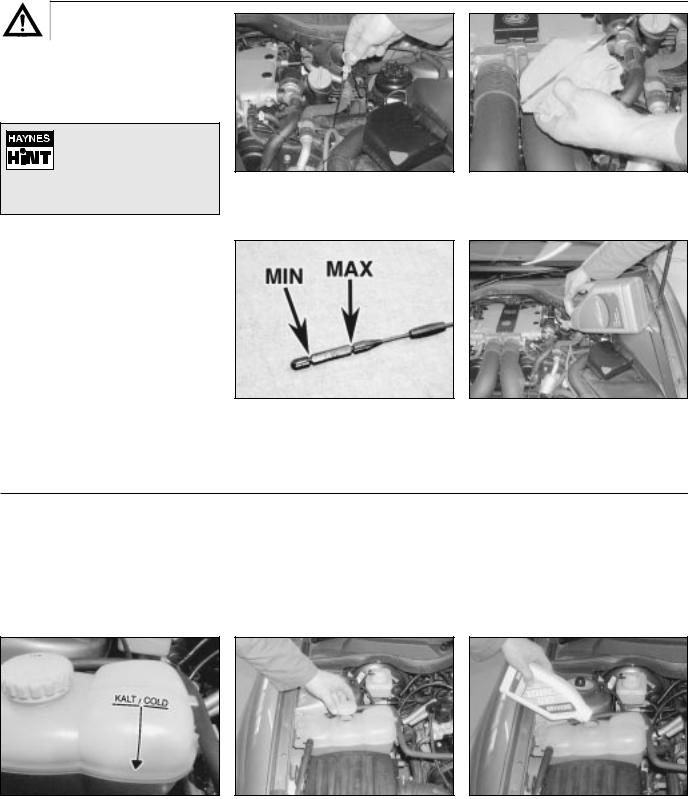
Weekly checks 0•11
Engine oil level
Before you start
Make sure that your car is on level ground.
Check the oil level before the car is driven, or at least 5 minutes after the engine has been switched off.
If the oil is checked |
immediately after driving the |
vehicle, some of the oil will |
remain in the upper engine |
components, resulting in an inaccurate |
reading on the dipstick! |
The correct oil
Modern engines place great demands on their oil. It is very important that the correct oil for your car is used (See “Lubricants and fluids” on page 0•16).
Car Care
●If you have to add oil frequently, you should check whether you have any oil leaks. Place some clean paper under the car overnight, and check for stains in the morning. If there are no leaks, the engine may be burning oil
(see “Fault Finding”).
●Always maintain the level between the upper and lower dipstick marks (see photo 3). If the level is too low severe engine damage may occur. Oil seal failure may result if the engine is overfilled by adding too much oil.
1 The dipstick is located on the left-hand side of the engine (see Underbonnet check points on page 0•10 for exact
location). Withdraw the dipstick.
3 dipstick, which should be between the upper (MAX) mark and lower (MIN) mark.
Approximately 1.0 litre of oil will raise the level from the lower mark to the upper mark.
2 Using a clean rag or paper towel remove all oil from the dipstick. Insert the clean dipstick into the tube as far as it will go,
then withdraw it again.
4 Oil is added through the filler cap. Rotate the cap through a quarter-turn anticlockwise and withdraw it. Top-up the level. A funnel may help to reduce spillage. Add the oil slowly, checking the level on the
dipstick often. Do not overfill.
Coolant level
Warning: DO NOT attempt to remove the expansion tank pressure cap when the engine is hot, as there is a very great risk of scalding. Do not leave open containers of coolant about, as it is poisonous.
Car Care
● With a sealed-type cooling system, adding coolant should not be necessary on a regular basis. If frequent topping-up is required, it is likely there is a leak. Check the radiator, all hoses and joint faces for signs of staining or wetness, and rectify as necessary.
● It is important that antifreeze is used in the cooling system all year round, not just during the winter months. Don’t top-up with water alone, as the antifreeze will become too diluted.
The coolant level varies with the |
If topping up is necessary, wait until the |
Add a mixture of water and antifreeze to |
1 temperature of the engine. When the |
2 engine is cold. Slowly unscrew the |
3 the expansion tank until the coolant level |
engine is cold, the coolant level should |
expansion tank cap, to release any |
is slightly above the KALT/COLD mark |
be slightly above the KALT/COLD mark on the |
pressure present in the cooling system, and |
then securely refit the expansion tank cap. |
side of the tank. When the engine is hot, the |
remove it. |
|
level will rise. |
|
|
3510 Vauxhall/Opel Omega
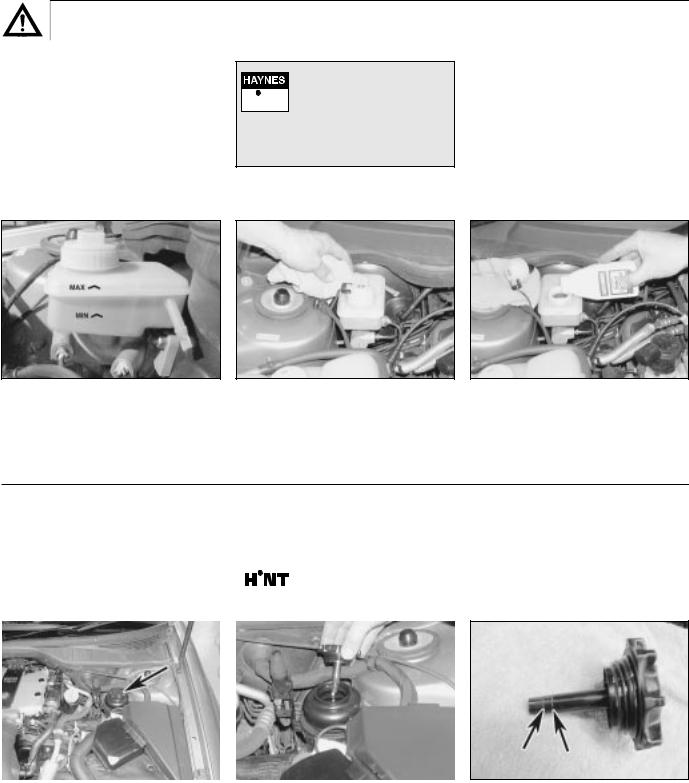
0•12 Weekly checks
Brake and clutch* fluid level
*On manual transmission models the brake fluid reservoir also supplies fluid to the clutch master cylinder.
Warning:
Brake fluid can harm your eyes and damage painted surfaces, so use extreme caution when handling and pouring it.
Do not use fluid that has been standing open for some time, as it absorbs moisture from the air, which can cause a dangerous loss of braking effectiveness.
• Make sure that your car is on level ground.


 • The fluid level in the reservoir will drop slightly as the brake pads wear down, but the fluid
• The fluid level in the reservoir will drop slightly as the brake pads wear down, but the fluid
level must never be allowed to drop below the “MIN” mark.
Safety First!
●If the reservoir requires repeated toppingup this is an indication of a fluid leak somewhere in the system, which should be investigated immediately.
●If a leak is suspected, the car should not be driven until the braking system has been checked. Never take any risks where brakes are concerned.
1 |
The upper (MAX) and lower (MIN) fluid |
2 |
If topping-up is necessary, first wipe |
3 |
Carefully add fluid, taking care not to spill |
level markings are on the side of the |
clean the area around the filler cap to |
it onto the surrounding components. Use |
|||
|
reservoir, which is located in the right- |
|
prevent dirt entering the hydraulic |
|
only the specified fluid; mixing different |
hand |
rear corner of the engine compartment. |
system. |
types |
can cause damage to the system. After |
|
The fluid level must always be kept in |
|
|
topping-up to the correct level, securely refit |
||
between these two marks. |
|
|
the cap and wipe off any spilt fluid. |
||
Power steering fluid level |
|
||||
Before you start: |
|
|
|
|
|
|
|
|
For the check to be |
||
|
|
|
|||
Park the vehicle on level ground. |
|
|
|
||
|
|
|
accurate, the steering must |
||
|
|
|
|||
Set the steering wheel straight-ahead. |
|
|
|
not be turned once the |
|
|
|
|
|||
The engine should be turned off. |
|
|
|
engine has been stopped. |
|
|
|
|
|
|
|
|
|
|
|
|
|
|
|
|
|
|
|
Safety First!
The need for frequent topping-up indicates a leak, which should be investigated immediately.
1 |
The power steering fluid reservoir is |
2 |
Wipe clean the filler cap dipstick then |
3 |
When the engine is cold the fluid level |
located on the left-hand side of the |
refit the filler cap and remove it again. |
should be up to the lower mark up the |
|||
|
engine compartment. Wipe clean the |
|
Note the fluid level on the dipstick. |
|
dipstick and when the engine is at |
reservoir before unscrewing and removing the |
|
|
operating temperature it should be at the |
||
cap. |
|
|
upper mark. Top up the fluid level using the |
||
|
|
|
|
specified type of fluid (do not overfill) then |
|
|
|
|
|
securely refit the filler cap. |
|
3510 Vauxhall/Opel Omega

Weekly checks 0•13
Battery
Caution: Before carrying out any work on the vehicle battery, read the precautions given in "Safety first" at the start of this manual.
Make sure that the battery tray is in good condition, and that the clamp is tight. Corrosion on the tray, retaining clamp and the battery itself can be removed with a solution of water and baking soda. Thoroughly rinse all cleaned areas with water. Any metal parts damaged by corrosion should be covered with a zinc-based primer, then painted.
Periodically (approximately every three months), check the charge condition of the battery as described in Chapter 5A.
If the battery is flat, and you need to jump start your vehicle, see Roadside Repairs.
Battery corrosion can be kept to a minimum by applying a layer of petroleum jelly to the clamps and terminals after they are reconnected.
1 The battery is located at the front lefthand corner of the engine compartment. If necessary, unclip the fusible link
housing (where fitted) from side of the relay box then open up the insulating cover to gain access to the battery.
3 If corrosion (white, fluffy deposits) is evident, remove the cables from the battery terminals, clean them with a small wire brush, then refit them. Automotive stores
sell a tool for cleaning the battery post . . .
2 The exterior of the battery should be inspected periodically for damage such as a cracked case or cover. Check the
battery lead clamps for tightness to ensure good electrical connections and check the leads for signs of damage.
4 . . . as well as the battery cable clamps
Electrical systems
Check all external lights and the horn. Refer to the appropriate Sections of Chapter 12 for details if any of the circuits are found to be inoperative.
Visually check all accessible wiring connectors, harnesses and retaining clips for security, and for signs of chafing or damage.
If you need to check your brake lights and indicators unaided, back up to a wall or garage door and operate the
lights. The reflected light should show if they are working properly.
1 |
If a single indicator light, stop-light or |
2 |
If more than one indicator light or tail light |
3 |
To replace a blown fuse, remove it, where |
headlight has failed, it is likely that a bulb |
has failed it is likely that either a fuse has |
applicable, using the plastic tool |
|||
|
has blown and will need to be replaced. |
|
blown or that there is a fault in the circuit |
|
provided. Fit a new fuse of the same |
Refer |
to Chapter 12 for details. If both stop |
(see |
Chapter 12). Most fuses are located behind |
rating, available from car accessory shops. It |
|
lights have failed, it is possible that the switch |
in the fusebox, behind the cover on the driver’s |
is important that you find the reason that the |
|||
has failed (see Chapter 12, Section 4). |
side of the facia; depress the locking button and |
fuse blew (see Electrical fault finding in |
|||
|
|
remove the cover to gain access. Additional |
Chapter 12). |
||
|
|
fuses can be found in the engine compartment |
|
|
|
|
|
relay box and fusible link housing. |
|
|
|
3510 Vauxhall/Opel Omega
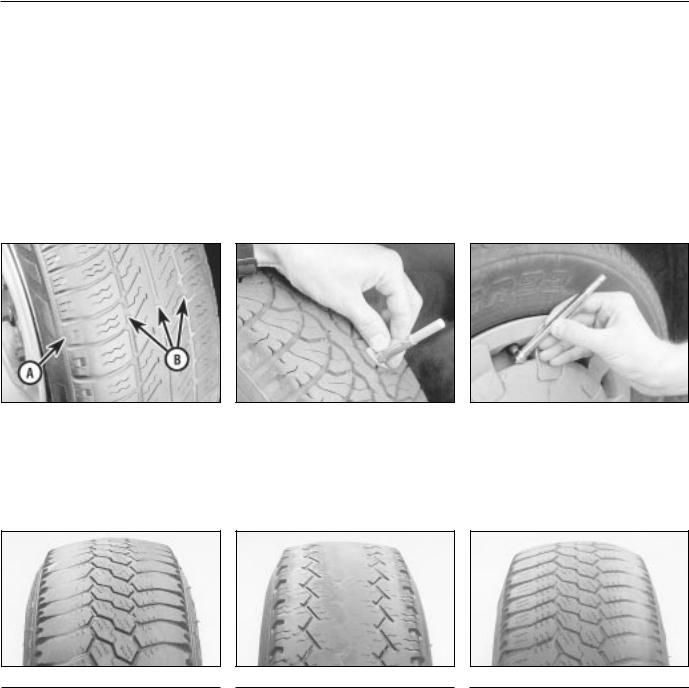
0•14 Weekly checks
Tyre condition and pressure
It is very important that tyres are in good condition, and at the correct pressure - having a tyre failure at any speed is highly dangerous. Tyre wear is influenced by driving style - harsh braking and acceleration, or fast cornering, will all produce more rapid tyre wear. As a general rule, the front tyres wear out faster than the rears. Interchanging the tyres from front to rear ("rotating" the tyres) may result in more even wear. However, if this is completely effective, you may have the expense of replacing all four tyres at once!
Remove any nails or stones embedded in the tread before they penetrate the tyre to cause deflation. If removal of a nail does reveal that
the tyre has been punctured, refit the nail so that its point of penetration is marked. Then immediately change the wheel, and have the tyre repaired by a tyre dealer.
Regularly check the tyres for damage in the form of cuts or bulges, especially in the sidewalls. Periodically remove the wheels, and clean any dirt or mud from the inside and outside surfaces. Examine the wheel rims for signs of rusting, corrosion or other damage. Light alloy wheels are easily damaged by "kerbing" whilst parking; steel wheels may also become dented or buckled. A new wheel is very often the only way to overcome severe damage.
New tyres should be balanced when they are fitted, but it may become necessary to rebalance them as they wear, or if the balance weights fitted to the wheel rim should fall off. Unbalanced tyres will wear more quickly, as will the steering and suspension components. Wheel imbalance is normally signified by vibration, particularly at a certain speed (typically around 50 mph). If this vibration is felt only through the steering, then it is likely that just the front wheels need balancing. If, however, the vibration is felt through the whole car, the rear wheels could be out of balance. Wheel balancing should be carried out by a tyre dealer or garage.
1 Tread Depth - visual check
The original tyres have tread wear safety bands (B), which will appear when the tread depth reaches approximately 1.6 mm. The band positions are indicated by a triangular mark on the tyre sidewall (A).
2 Tread Depth - manual check
Alternatively, tread wear can be monitored with a simple, inexpensive device known as a tread depth indicator gauge.
3 Tyre Pressure Check
Check the tyre pressures regularly with the tyres cold. Do not adjust the tyre pressures immediately after the vehicle has been used, or an inaccurate setting will result. Tyre pressures are shown on page 0•17.
Tyre tread wear patterns
Shoulder Wear
Underinflation (wear on both sides)
Under-inflation will cause overheating of the tyre, because the tyre will flex too much, and the tread will not sit correctly on the road surface. This will cause a loss of grip and excessive wear, not to mention the danger of sudden tyre failure due to heat build-up.
Check and adjust pressures
Incorrect wheel camber (wear on one side)
Repair or renew suspension parts
Hard cornering
Reduce speed!
Centre Wear
Overinflation
Over-inflation will cause rapid wear of the centre part of the tyre tread, coupled with reduced grip, harsher ride, and the danger of shock damage occurring in the tyre casing.
Check and adjust pressures
If you sometimes have to inflate your car’s tyres to the higher pressures specified for maximum load or sustained high speed, don’t forget to reduce the pressures to normal afterwards.
Uneven Wear
Front tyres may wear unevenly as a result of wheel misalignment. Most tyre dealers and garages can check and adjust the wheel alignment (or "tracking") for a modest charge.
Incorrect camber or castor
Repair or renew suspension parts
Malfunctioning suspension
Repair or renew suspension parts
Unbalanced wheel
Balance tyres
Incorrect toe setting
Adjust front wheel alignment
Note: The feathered edge of the tread which typifies toe wear is best checked by feel.
3510 Vauxhall/Opel Omega

Weekly checks 0•15
Washer fluid level
Screenwash additives not only keep the winscreen clean during foul weather, they also prevent the washer system freezing in cold
weather - which is when you are likely to need it most. Don’t top up using plain water as the screenwash will become too diluted, and will
freeze during cold weather. On no account use coolant antifreeze in the washer system - this could discolour or damage paintwork.
1 The reservoir for the windscreen/ tailgate/headlamps (as applicable) is located at the front of vehicle. The fluid level in the reservoir can be checked using the
dipstick attached to the filler cap.
2 When topping-up the reservoir, a screenwash additive should be added in the quantities recommended on the
bottle.
Wiper blades
1 Check the condition of the wiper blades; if they are cracked or show any signs of deterioration, or if the glass swept area is smeared, renew them. Wiper blades should
be renewed annually.
2 To remove a windscreen wiper blade, pull the arm fully away from the screen until it locks. Swivel the blade through 90°, press the locking tab with your fingers and
slide the blade out of the arm’s hooked end.
3510 Vauxhall/Opel Omega

0•16 Lubricants and fluids
Lubricants and fluids
Engine . . . . . . . . . . . . . . . . . . . . . . . . . . . . . . . . . . . . . . . . . . . .
Cooling system . . . . . . . . . . . . . . . . . . . . . . . . . . . . . . . . . . . . .
Manual transmission:
Early (pre 1999) vehicles:
Up to number JP3097A01361659* . . . . . . . . . . . . . . . . . . .
From number JP3097A01361659* . . . . . . . . . . . . . . . . . . .
Later (1999 onwards) vehicles . . . . . . . . . . . . . . . . . . . . . . . .
Automatic transmission . . . . . . . . . . . . . . . . . . . . . . . . . . . . . .
Final drive unit . . . . . . . . . . . . . . . . . . . . . . . . . . . . . . . . . . . . .
Braking and clutch system . . . . . . . . . . . . . . . . . . . . . . . . . . .
Power steering . . . . . . . . . . . . . . . . . . . . . . . . . . . . . . . . . . . . .
Multigrade engine oil, viscosity SAE 10W/40 to 15W/50 to API SG/CD or SH/CD
(Duckhams QXR Premium Petrol Engine Oil or Duckhams Hypergrade Petrol Engine Oil) Ethylene glycol based antifreeze
(Duckhams Antifreeze and Summer Coolant)
Vauxhall transmission oil 19 40 704
Vauxhall transmission oil 19 40 764
Vauxhall transmission oil 19 40 768
Vauxhall transmission fluid 19 40 763 (Duckhams ATF Autotrans III)
See Chapter 8 specifications
Hydraulic fluid DOT 4
(Duckhams Universal Brake and Clutch Fluid)
Vauxhall transmission fluid 19 40 700 (Duckhams ATF Autotrans III)
*The identification number is stamped on the transmission housing. Note: There have been three different types of oil used in the transmission by Vauxhall. The different types of oil should never be mixed, and it is essential that the transmission is refilled either with the same type of oil as that drained, or the latest oil used in production from 1999 model year. If it is not known what type of oil has been drained, the transmission unit should be flushed before filling with the latest specification oil. To do this, refer to Chapter 7A, Section 2.
Choosing your engine oil
Engines need oil, not only to lubricate moving parts and minimise wear, but also to maximise power output and to improve fuel economy. By introducing a simplified and improved range of engine oils, Duckhams has taken away the confusion and made it easier for you to choose the right oil for your engine.
HOW ENGINE OIL WORKS
• Beating friction
Without oil, the moving surfaces inside your engine will rub together, heat up and melt, quickly causing the engine to seize. Engine oil creates a film which separates these moving parts, preventing wear and heat build-up.
• Cooling hot-spots
Temperatures inside the engine can exceed 1000º C. The engine oil circulates and acts as a coolant, transferring heat from the hot-spots to the sump.
• Cleaning the engine internally
Good quality engine oils clean the inside of your engine, collecting and dispersing combustion deposits and controlling them until they are trapped by the oil filter or flushed out at oil change.
OIL CARE - FOLLOW THE CODE
To handle and dispose of used engine oil safely, always:
•Avoid skin contact with used engine oil. Repeated or prolonged contact can be harmful.
•Dispose of used oil and empty packs in a responsible manner in an authorised disposal site. Call 0800 663366 to find the one nearest to you. Never tip oil down drains or onto the ground.
DUCKHAMS ENGINE OILS
For the driver who demands a premium quality oil for complete reassurance, we recommend synthetic formula Duckhams QXR Premium Engine Oils.
For the driver who requires a straightforward quality engine oil, we recommend
Duckhams Hypergrade Engine Oils.
For further information and advice, call the Duckhams UK Helpline on 0800 212988.
3510 Vauxhall/Opel Omega

Tyre pressures 0•17
Tyre pressures
Note: Pressures apply to original-equipment tyres only and may vary if any other make or type of tyre is fitted; check with the tyre manufacturer or supplier for correct pressures if necessary.
Note: Tyre pressures must always be checked with the tyres cold to ensure accuracy.
Saloon models
2.0 litre engine |
Front |
Rear |
Up to 3 passengers (including driver) . . . . . . . . . . . . . . . . . . . . |
28.5 psi (2.0 bar) |
28.5 psi (2.0 bar) |
Fully loaded . . . . . . . . . . . . . . . . . . . . . . . . . . . . . . . . . . . . . . . . |
36 psi (2.5 bar) |
42 psi (2.9 bar) |
2.5 and 3.0 litre engine |
|
|
Up to 3 passengers (including driver) . . . . . . . . . . . . . . . . . . . . |
31.5 psi (2.2 bar) |
31.5 psi (2.2 bar) |
Fully loaded . . . . . . . . . . . . . . . . . . . . . . . . . . . . . . . . . . . . . . . . |
36 psi (2.5 bar) |
42 psi (2.9 bar) |
Estate models |
|
|
2.0 litre engine |
|
|
Up to 3 passengers (including driver) . . . . . . . . . . . . . . . . . . . . |
28.5 psi (2.0 bar) |
31.5 psi (2.2 bar) |
4 or 5 passengers (including driver) and 60 kg of luggage . . . . |
33.0 psi (2.3 bar) |
45.0 psi (3.1 bar) |
Fully loaded . . . . . . . . . . . . . . . . . . . . . . . . . . . . . . . . . . . . . . . . |
38.0 psi (2.6 bar) |
45.0 psi (3.1 bar) |
2.5 and 3.0 litre engine |
|
|
195/65 R 15 tyres: |
|
|
Up to 3 passengers (including driver) . . . . . . . . . . . . . . . . . . . |
31.5 psi (2.2 bar) |
34.0 psi (2.3 bar) |
4 or 5 passengers (including driver) and 60 kg of luggage . . . |
34.0 psi (2.3 bar) |
46.0 psi (3.2 bar) |
Fully loaded . . . . . . . . . . . . . . . . . . . . . . . . . . . . . . . . . . . . . . |
39.0 psi (2.7 bar) |
46.0 psi (3.2 bar) |
205/65 R 15 and 225/55 R 15 tyres: |
|
|
Up to 3 passengers (including driver) . . . . . . . . . . . . . . . . . . . |
28.5 psi (2.0 bar) |
31.5 psi (2.2 bar) |
4 or 5 passengers (including driver) and 60 kg of luggage . . . |
33.0 psi (2.3 bar) |
45.0 psi (3.1 bar) |
Fully loaded . . . . . . . . . . . . . . . . . . . . . . . . . . . . . . . . . . . . . . |
38.0 psi (2.6 bar) |
45.0 psi (3.1 bar) |
3510 Vauxhall/Opel Omega
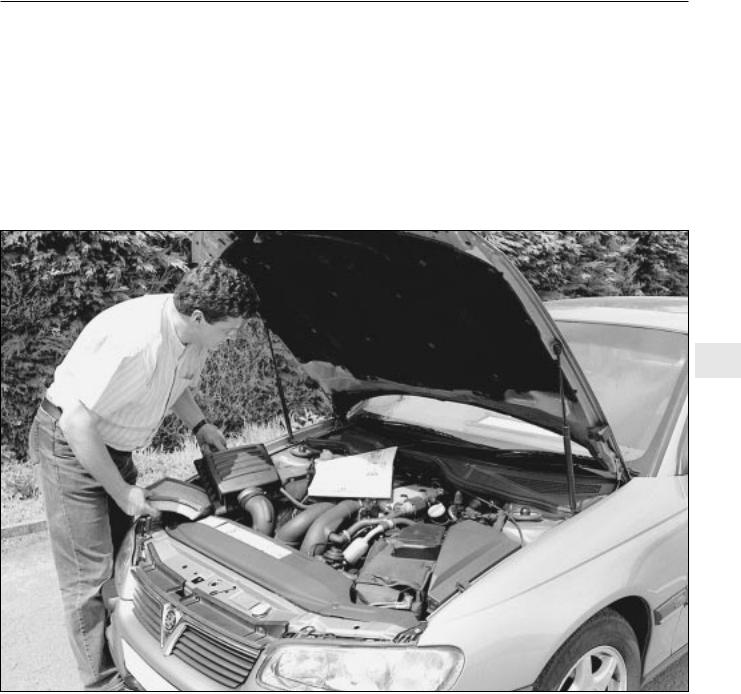
1•1
Chapter 1
Routine maintenance and servicing
Contents
Air filter element - renewal . . . . . . . . . . . . . . . . . . . . . . . . . . . . . . . . . 16 Automatic transmission fluid - renewal . . . . . . . . . . . . . . . . . . . . . . . 25 Automatic transmission fluid level - check . . . . . . . . . . . . . . . . . . . . 19 Auxiliary drivebelt - check and renewal . . . . . . . . . . . . . . . . . . . . . . . 6 Bodywork/underbody corrosion protection - check . . . . . . . . . . . . . 8 Brake fluid - renewal . . . . . . . . . . . . . . . . . . . . . . . . . . . . . . . . . . . . . 26 Coolant - renewal . . . . . . . . . . . . . . . . . . . . . . . . . . . . . . . . . . . . . . . 28 Driveshaft gaiter condition - check . . . . . . . . . . . . . . . . . . . . . . . . . . 21 Engine oil and filter - renewal . . . . . . . . . . . . . . . . . . . . . . . . . . . . . . 3 Exhaust system - check . . . . . . . . . . . . . . . . . . . . . . . . . . . . . . . . . . 15 Front and rear disc brakes - pad wear check . . . . . . . . . . . . . . . . . . 5 Fuel filter - renewal . . . . . . . . . . . . . . . . . . . . . . . . . . . . . . . . . . . . . . 23 General information . . . . . . . . . . . . . . . . . . . . . . . . . . . . . . . . . . . . . . 1 Handbrake - shoe condition check . . . . . . . . . . . . . . . . . . . . . . . . . . 20
Handbrake operation - check and adjustment . . . . . . . . . . . . . . . . . 9 Headlight and auxiliary driving light beam alignment - check . . . . . . 12 Lock and hinge lubrication . . . . . . . . . . . . . . . . . . . . . . . . . . . . . . . . 18 Monitoring, lighting and signalling equipment - check . . . . . . . . . . . 4 Pollen filter - renewal . . . . . . . . . . . . . . . . . . . . . . . . . . . . . . . . . . . . . 17 Regular maintenance . . . . . . . . . . . . . . . . . . . . . . . . . . . . . . . . . . . . . 2 Remote control keyfob battery - renewal . . . . . . . . . . . . . . . . . . . . . 27 Road test . . . . . . . . . . . . . . . . . . . . . . . . . . . . . . . . . . . . . . . . . . . . . . 13 Spark plugs - renewal . . . . . . . . . . . . . . . . . . . . . . . . . . . . . . . . . . . . 22 Suspension and steering condition and operation - check . . . . . . . . 10 Timing belt - renewal . . . . . . . . . . . . . . . . . . . . . . . . . . . . . . . . . . . . . 24 Underbonnet/underbody hose and fluid leak - check . . . . . . . . . . . . 7 Wheel alignment - check . . . . . . . . . . . . . . . . . . . . . . . . . . . . . . . . . . 14 Wheel bolt torque - check and adjustment . . . . . . . . . . . . . . . . . . . . 11
1
Degrees of difficulty
|
|
|
|
|
|
|
|
|
|
|
|
|
|
|
Easy, suitable for |
1 |
|
Fairly easy, suitable |
2 |
|
Fairly difficult, |
3 |
|
Difficult, suitable for |
4 |
|
Very difficult, |
5 |
|
|
|
|
|
|
||||||||||
novice with little |
|
for beginner with |
|
suitable for competent |
|
experienced DIY |
|
suitable for expert DIY |
|
|||||
experience |
|
some experience |
|
DIY mechanic |
|
mechanic |
|
or professional |
|
|||||
|
|
|
|
|
|
|
|
|
|
|
|
|
|
|
|
|
|
|
|
|
|
|
|
|
|
|
|
|
|
3510 Vauxhall/Opel Omega

1•2 Servicing specifications
Lubricants and fluids . . . . . . . . . . . . . . . . . . . . . . . . . . . . . . . . . . |
Refer to end of Weekly checks on page 0•16 |
|
Capacities |
|
|
Engine oil |
|
|
2.0 litre engine: |
|
|
SOHC engine . . . . . . . . . . . . . . . . . . . . . . . . . . . . . . . . . . . . . . . . . |
4.5 litres |
|
DOHC engine: |
|
|
Engines with a one-piece sump . . . . . . . . . . . . . . . . . . . . . . . . . |
4.5 litres |
|
Engines with a two-piece sump . . . . . . . . . . . . . . . . . . . . . . . . . |
5.0 litres |
|
2.5 and 3.0 litre engine . . . . . . . . . . . . . . . . . . . . . . . . . . . . . . . . . . . . |
5.75 litres |
|
Difference between MIN and MAX on dipstick (all engines) . . . . . . . . . . |
1.0 litre |
|
Cooling system |
Manual transmission |
Automatic transmission |
2.0 litre engine: |
|
|
SOHC engine . . . . . . . . . . . . . . . . . . . . . . . . . . . . . . . . . . . . . . . . . . . |
9.0 litres |
8.8 litres |
DOHC engine . . . . . . . . . . . . . . . . . . . . . . . . . . . . . . . . . . . . . . . . . . . |
8.8 litres |
8.6 litres |
2.5 and 3.0 litre engine . . . . . . . . . . . . . . . . . . . . . . . . . . . . . . . . . . . . . . |
9.7 litres |
9.5 litres |
Transmission |
|
|
Manual transmission (approximate) . . . . . . . . . . . . . . . . . . . . . . . . . . . . |
1.2 litres |
|
Automatic transmission (approximate): |
|
|
From dry . . . . . . . . . . . . . . . . . . . . . . . . . . . . . . . . . . . . . . . . . . . . . . . |
8.4 litres |
|
After removing main sump . . . . . . . . . . . . . . . . . . . . . . . . . . . . . . . . . |
4.4 litres |
|
Final drive . . . . . . . . . . . . . . . . . . . . . . . . . . . . . . . . . . . . . . . . . . . . . . . . |
1.0 litre* |
|
*On models with limited-slip differential, observe the notes in Chapter 8 regarding the correct mixture of oil and additive to be used when refilling the final drive unit.
Washer fluid reservoir |
|
Without headlight washers . . . . . . . . . . . . . . . . . . . . . . . . . . . . . . . . . . . |
3.0 litres |
With headlight washers . . . . . . . . . . . . . . . . . . . . . . . . . . . . . . . . . . . . . |
6.4 litres |
Fuel tank |
|
All models . . . . . . . . . . . . . . . . . . . . . . . . . . . . . . . . . . . . . . . . . . . . . . . . |
75 litres |
Engine
Oil filter . . . . . . . . . . . . . . . . . . . . . . . . . . . . . . . . . . . . . . . . . . . . . . . . . . Champion G102
Cooling system
Antifreeze mixture: |
|
50% antifreeze . . . . . . . . . . . . . . . . . . . . . . . . . . . . . . . . . . . . . . . . . . |
Protection down to -37ºC |
55% antifreeze . . . . . . . . . . . . . . . . . . . . . . . . . . . . . . . . . . . . . . . . . . |
Protection down to -45ºC |
Note: Refer to antifreeze manufacturer for latest recommendations. |
|
Fuel system
Air filter element: |
|
2.0 litre engine . . . . . . . . . . . . . . . . . . . . . . . . . . . . . . . . . . . . . . . . . . |
Champion U595 |
2.5 and 3.0 litre engine . . . . . . . . . . . . . . . . . . . . . . . . . . . . . . . . . . . . |
Champion U601 |
Fuel filter . . . . . . . . . . . . . . . . . . . . . . . . . . . . . . . . . . . . . . . . . . . . . . . . . |
Champion L225 |
Ignition system
Spark plugs (gap not adjustable - see text) . . . . . . . . . . . . . . . . . . . . . . Champion RC10DMC
Brakes
Friction material minimum thickness: |
|
Front brake pads . . . . . . . . . . . . . . . . . . . . . . . . . . . . . . . . . . . . . . . . . |
8.0 mm including backing plate |
Rear brake pads . . . . . . . . . . . . . . . . . . . . . . . . . . . . . . . . . . . . . . . . . |
6.0 mm including backing plate |
Handbrake shoes . . . . . . . . . . . . . . . . . . . . . . . . . . . . . . . . . . . . . . . . |
1.0 mm excluding backing plate |
Torque wrench settings |
Nm |
lbf ft |
Automatic transmission fluid level plug . . . . . . . . . . . . . . . . . . . . . . . . . |
33 |
24 |
Oil filter . . . . . . . . . . . . . . . . . . . . . . . . . . . . . . . . . . . . . . . . . . . . . . . . . . |
15 |
11 |
Roadwheel bolts . . . . . . . . . . . . . . . . . . . . . . . . . . . . . . . . . . . . . . . . . . . |
110 |
81 |
Spark plugs . . . . . . . . . . . . . . . . . . . . . . . . . . . . . . . . . . . . . . . . . . . . . . . |
25 |
18 |
Sump drain plug: |
|
|
2.0 litre SOHC engine . . . . . . . . . . . . . . . . . . . . . . . . . . . . . . . . . . . . . |
55 |
41 |
2.0 litre DOHC engine: |
|
|
Hex-head bolt . . . . . . . . . . . . . . . . . . . . . . . . . . . . . . . . . . . . . . . . . |
45 |
33 |
Torx-head bolt . . . . . . . . . . . . . . . . . . . . . . . . . . . . . . . . . . . . . . . . . |
10 |
7 |
2.5 and 3.0 litre engine: |
|
|
Hex-head bolt . . . . . . . . . . . . . . . . . . . . . . . . . . . . . . . . . . . . . . . . . |
55 |
41 |
Torx-head bolt . . . . . . . . . . . . . . . . . . . . . . . . . . . . . . . . . . . . . . . . . |
10 |
7 |
3510 Vauxhall/Opel Omega

Maintenance schedule 1•3
The maintenance intervals in this manual are provided with the assumption that you, not the dealer, will be carrying out the work. These are the minimum maintenance intervals recommended by us for vehicles driven daily. If you wish to keep your vehicle in peak condition at all times, you may wish to
perform some of these procedures more often. We encourage frequent maintenance, because it enhances the efficiency, performance and resale value of your vehicle.
If the vehicle is driven in dusty areas, used to tow a trailer, or driven frequently at slow speeds (idling in traffic) or on short journeys,
more frequent maintenance intervals are recommended.
When the vehicle is new, and/or still within its warranty period, it should be serviced by a factory-authorised dealer service department, in order to preserve the factory warranty.
Every 5000 miles (7500 km) or 6 months, whichever comes first
m Engine oil and filter - renewal (Section 3)
Note: Vauxhall recommend that the engine oil and filter are changed every 10 000 miles or 12 months. However, oil and filter changes are good for the engine and we recommend that the oil and filter are renewed more frequently, especially if the vehicle is used on a lot of short journeys.
Every 10 000 miles (15 000 km) or 12 months, whichever comes first
mMonitoring, lighting and signalling equipment - check (Section 4)
mFront and rear brakes - pad and disc wear check (Section 5)
mAuxiliary drivebelt condition and tension - check and adjust (Section 6)*
mUnderbonnet/underbody hose and fluid leak - check (Section 7)*
mBodywork/underbody corrosion protection - check (Section 8)*
mHandbrake operation - check and adjustment (Section 9)*
mSuspension and steering condition and operation - check (Section 10)*
mWheel bolt torque - check and adjustment (Section 11)
mHeadlight and auxiliary driving light beam alignment - check (Section 12)*
mRoad test (Section 13)
mWheel alignment - check (Section 14)
mExhaust system - check (Section 15)*
* Note: On vehicles covering a high mileage (more than 20 000 miles/30 000 km annually) carry out the items marked with an asterisk at the 12 month interval; carry out the items not marked with an asterisk every 10 000 miles/15 000 km, regardless of elapsed time.
Every 20 000 miles (30 000 km) or 2 years, whichever comes first
Carry out all the operations listed for the 15,000 km/12 month interval, plus the following additional operations:
mAir filter element - renewal (Section 16)
mPollen filter - renewal (Section 17)
mLock and hinge lubrication (Section 18)
mAutomatic transmission fluid level check (Section 19)
mHandbrake - shoe condition check (Section 20)
mDriveshaft gaiter condition - check (Section 21)
Every 40 000 miles (60 000 km) or 4 years, whichever comes first
Carry out all the operations listed for the 15,000 km/12 month and the 30,000 km/2 year intervals, plus the following additional operations:
mSpark plugs - renewal (Section 22)*
mFuel filter - renewal (Section 23)
mTiming belt - renewal (Section 24)**
* Note: On pre-1999 model year vehicles, renew the spark plugs every 40 000 miles (60 000 km) regardless of the time elapsed.
**Note: Since the introduction of the Omega in 1994, Vauxhall have gradually increased the specified interval for timing belt renewal as follows:
1994 model year vehicle,
36 000 miles or 4 years, whichever comes first.
1995 and 1996 model year vehicles,
40 000 miles or 4 years, whichever comes first.
1997 model year vehicles onwards,
80 000 miles or 8 years, whichever comes first.
However, if the vehicle is used mainly for short journeys or a lot of stop-start driving, or if the vehicle’s history is unknown, it is 1 recommended that the earlier (1994 model year) recommendation is adhered to. The actual belt renewal interval is very much up to the individual owner but, bearing in mind that severe engine damage will result if the belt breaks in use, we recommend you err on the side of caution.
Every 70 000 miles (105 000 km) or 7 years whichever comes first
m Automatic transmission fluid - renewal (Section 25)*
Note: This operation applies only to vehicles covering a high mileage (more than 20 000 miles/30 000 km annually)
Every 2 years, regardless of mileage
mBrake fluid - renewal (Section 26)
mRemote control keyfob battery - renewal (Section 27)
mCoolant - renewal (Section 28)
3510 Vauxhall/Opel Omega
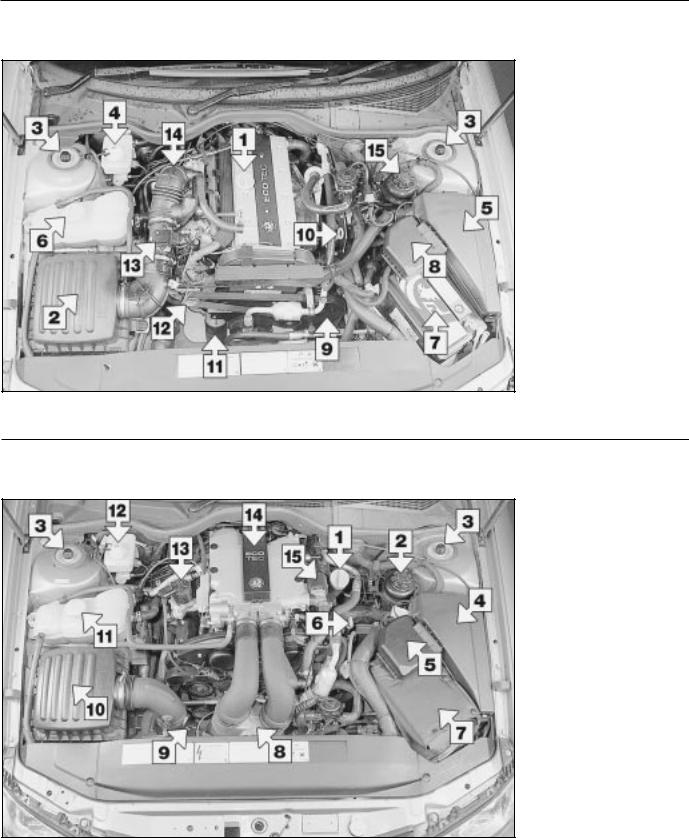
1•4 Maintenance - component location
Underbonnet view of a 2.0 litre DOHC engine model
1 |
Engine oil filler cap |
2 |
Air cleaner |
3 |
Front suspension strut |
|
upper mounting |
4 |
Brake (and clutch) fluid |
|
reservoir |
5 |
Relay box |
6 |
Cooling system expansion |
|
tank |
7 |
Battery |
8 |
Fusible link housing |
9 |
Power steering pump |
10 |
Engine oil level dipstick |
11 |
Oil filter |
12 |
Alternator |
13 |
Airflow meter |
14 |
Throttle housing |
15 |
Power steering fluid |
|
reservoir |
Underbonnet view of a 2.5 litre engine model (3.0 litre engine similar)
1 |
Engine oil filler cap |
2 |
Power steering fluid |
|
reservoir |
3 |
Front suspension strut |
|
upper mounting |
4 |
Relay box |
5 |
Fusible link housing |
6 |
Engine oil level dipstick |
7 |
Battery |
8 |
Multi-ram air intake system |
|
pre-volume chamber |
9 |
Airflow meter |
10 |
Air cleaner |
11 |
Cooling system expansion |
|
tank |
12 |
Brake (and clutch) fluid |
|
reservoir |
13 |
Exhaust gas recirculation |
|
(EGR) valve |
14 |
Inlet manifold |
15 |
Idle speed adjuster valve |
3510 Vauxhall/Opel Omega
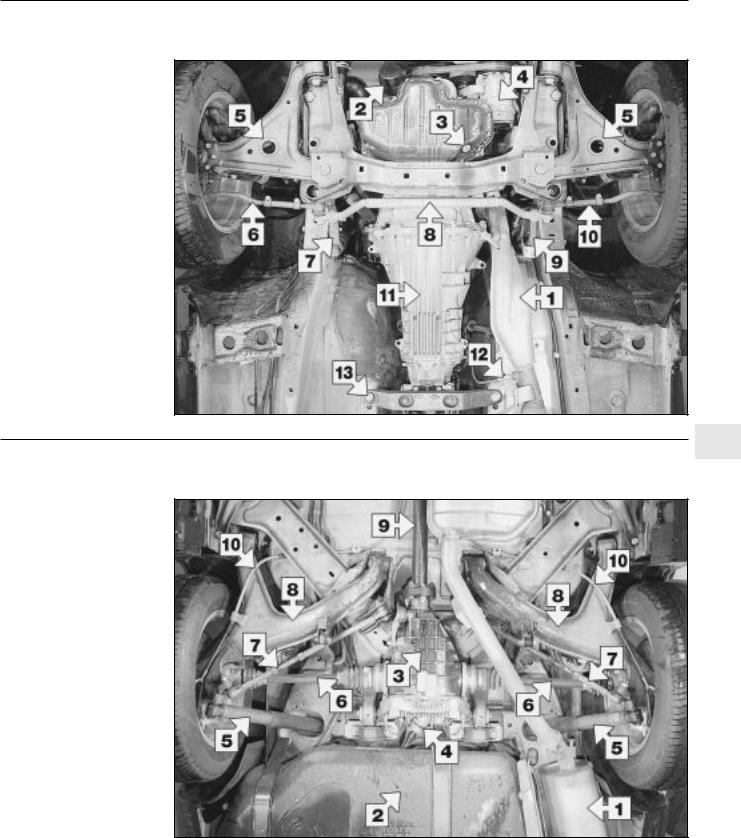
Maintenance - component location 1•5
Front underbody view (2.0 litre DOHC engine shown - others similar)
1Exhaust front downpipe
2Oil filter
3Engine oil drain plug
4Air conditioning system compressor
5Front suspension lower arm
6Steering outer tie rod
7Steering drop arm
8Steering centre tie rod
9Steering idler
10Steering outer tie rod
11Manual transmission
12Oxygen sensor
13Transmission unit rear mounting crossmember
1
Rear underbody view (2.0 litre DOHC engine shown - others similar)
1Exhaust tailpipe
2Fuel tank
3Final drive unit
4Fuel filter
5Rear shock absorber
6Driveshaft
7Rear suspension tie rod
8Rear suspension lower arm
9Propeller shaft
10Handbrake cable
3510 Vauxhall/Opel Omega
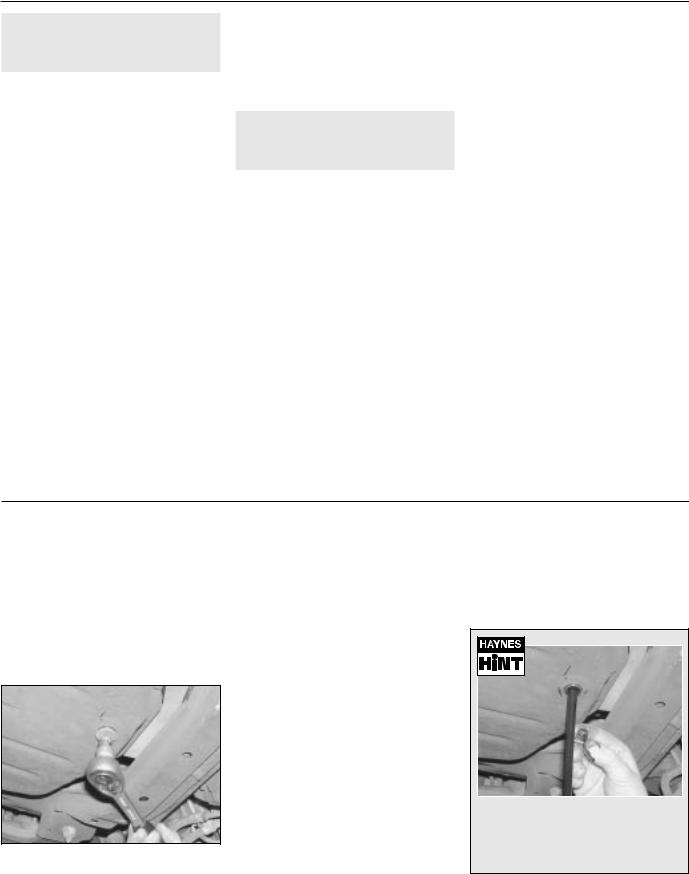
1•6 Maintenance procedures
1 General information
1This Chapter is designed to help the home mechanic maintain his/her vehicle for safety, economy, long life and peak performance.
2The Chapter contains a master maintenance schedule, followed by Sections dealing specifically with each task in the schedule. Visual checks, adjustments, component renewal and other helpful items are included. Refer to the accompanying illustrations of the engine compartment and the underside of the vehicle for the locations of the various components.
3Servicing your vehicle in accordance with the mileage/time maintenance schedule and the following Sections will provide a planned maintenance programme, which should result in a long and reliable service life. This is a comprehensive plan, so maintaining some items but not others at the specified service intervals, will not produce the same results.
4As you service your vehicle, you will discover that many of the procedures can - and should - be grouped together, because of the particular procedure being performed, or because of the proximity of two otherwiseunrelated components to one another. For example, if the vehicle is raised for any reason, the exhaust can be inspected at the same time as the suspension and steering components.
5The first step in this maintenance pro-
gramme is to prepare yourself before the actual work begins. Read through all the Sections relevant to the work to be carried out, then make a list and gather all the parts and tools required. If a problem is encountered, seek advice from a parts specialist, or a dealer service department.
2 Regular maintenance
1 If, from the time the vehicle is new, the routine maintenance schedule is followed closely, and frequent checks are made of fluid levels and high-wear items, as suggested throughout this manual, the engine will be kept in relatively good running condition, and the need for additional work will be minimised.
2It is possible that there will be times when the engine is running poorly due to the lack of regular maintenance. This is even more likely if a used vehicle, which has not received regular and frequent maintenance checks, is purchased. In such cases, additional work may need to be carried out, outside of the regular maintenance intervals.
3If engine wear is suspected, a compression test (refer to Chapter 2A, 2B or 2C, as applicable) will provide valuable information regarding the overall performance of the main internal components. Such a test can be used as a basis to decide on the extent of the work to be carried out. If, for example, a
compression test indicates serious internal engine wear, conventional maintenance as described in this Chapter will not greatly improve the performance of the engine, and may prove a waste of time and money, unless extensive overhaul work is carried out first.
4 The following series of operations are those most often required to improve the performance of a generally poor-running engine:
Primary operations
a)Clean, inspect and test the battery (refer to Weekly checks).
b)Check all the engine-related fluids (refer to Weekly checks).
c)Check the condition and tension of the auxiliary drivebelt (Section 6).
d)Renew the spark plugs (Section 22).
e)Check the condition of the air filter, and renew if necessary (Section 16).
f)Renew the fuel filter (Section 23).
g)Check the condition of all hoses, and
check for fluid leak.
5 If the above operations do not prove fully effective, carry out the following secondary operations:
Secondary operations
All items listed under Primary operations, plus the following:
a)Check the charging system (refer to Chapter 5A).
b)Check the ignition system (refer to Chapter 5B).
c)Check the fuel system (refer to Chapter 4A).
Every 5000 miles or 6 months
3 Engine oil and filter - |
2 |
renewal |
|
|
|
1Frequent oil and filter changes are the most important preventative maintenance procedures which can be undertaken by the DIY owner. As engine oil ages, it becomes diluted and contaminated, which leads to premature engine wear.
2Before starting this procedure, gather together all the necessary tools and materials.
3.5 Removing the sump drain plug
Also make sure that you have plenty of clean rags and newspapers handy, to mop up any spills. Ideally, the engine oil should be warm, as it will drain more easily, and more built-up sludge will be removed with it. Take care not to touch the exhaust or any other hot parts of the engine when working under the vehicle. To avoid any possibility of scalding, and to protect yourself from possible skin irritants and other harmful contaminants in used engine oils, it is advisable to wear gloves when carrying out this work.
3Firmly apply the handbrake then jack up the front of the vehicle and support it on axle stands (see Jacking and Vehicle Support). Undo the retaining screws and remove the undercover from beneath the engine unit.
4Remove the oil filler cap.
5Using a spanner, or preferably a suitable socket and bar, slacken the drain plug about half a turn (see illustration). Position the draining container under the drain plug, then remove the plug completely (see Haynes Hint).
6Allow some time for the oil to drain, noting that it may be necessary to reposition the container as the oil flow slows to a trickle.
7After all the oil has drained, wipe the drain plug and the sealing washer with a clean rag.
Examine the condition of the sealing washer, and renew it if it shows signs of scoring or other damage which may prevent an oil-tight seal. Clean the area around the drain plug opening, and refit the plug complete with the washer and tighten it to the specified torque.
8 Move the container into position under the oil filter. On 2.0 litre engines the filter is located on the front end of the engine, where
As the drain plug releases from the threads, move it quickly away so that the stream of oil running out of the sump goes into the container and not over your arm
3510 Vauxhall/Opel Omega
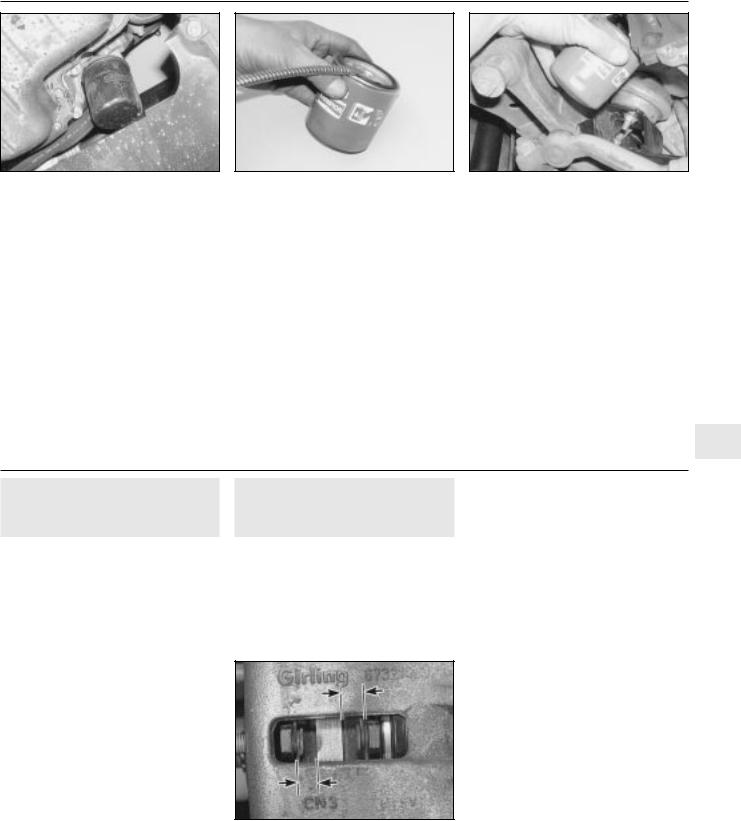
Every 5000 miles 1•7
3.8 Oil filter location - 2.0 litre engine
it is screwed onto the oil pump housing, and on 2.5 and 3.0 litre engines it is screwed onto the left-hand side of the cylinder block (see illustration).
9Use an oil filter removal tool to slacken the filter initially, then unscrew it by hand the rest of the way. Empty the oil from the old filter into the container.
10Use a clean rag to remove all oil, dirt and sludge from the filter sealing area on the engine.
11Apply a light coating of clean engine oil to the sealing ring on the new filter, then screw the filter into position on the engine. Tighten the filter firmly by hand only - do not use any tools (see illustrations). If a genuine filter is being fitted and the special oil filter
filter with a smear of engine oil . . .
tool (Tool no. KM-726A - a socket which fits over the end of the filter) is available, tighten the filter to the specified torque.
12 Refit the undercover, tightening its retaining screws securely, then remove the old oil and all tools from under the vehicle before lowering the vehicle to the ground.
13 Fill the engine through the filler hole, using the correct grade and type of oil (refer to Weekly Checks for details of topping-up). Pour in half the specified quantity of oil first, then wait a few minutes for the oil to drain into the sump. Continue to add oil, a small quantity at a time, until the level is up to the lower mark on the dipstick. Adding approximately a further 1.0 litre will bring the level up to the upper mark on the dipstick.
3.11b . . . then screw the filter on by hand only (2.5 litre engine shown)
14 Start the engine and run it for a few minutes, while checking for leaks around the oil filter seal and the sump drain plug. Note that there may be a delay of a few seconds before the low oil pressure warning light goes out when the engine is first started, as the oil circulates through the new oil filter and the engine oil galleries before the pressure builds up.
15Stop the engine, and wait a few minutes for the oil to settle in the sump once more. With the new oil circulated and the filter now completely full, recheck the level on the dipstick, and add more oil as necessary.
16Dispose of the used engine oil safely with reference to General repair procedures.
1
Every 10 000 miles or 12 months
4 Monitoring, lighting and signalling equipment - 1 check
1 Turn the ignition switch to the second position and check that the instrument panel CHECK lamp lights up and then extinguishes after 4 approximately seconds. If the lamp fails to extinguish, observe the fault description message(s) displayed and rectify the cause.
2Start the engine and check that all tell-tale system operation/fault lamps extinguish. Note that some lamps (such as the automatic transmission sport programme, or traction control system lamps) may remain lit, depending on the driving mode selected; consult your drivers handbook for the exact meaning of each lamp.
3Release handbrake, depress the brake pedal and check that the brake lights fault display extinguishes.
4Switch on all interior and exterior lights in turn and check their operation. Pay particular attention to the tail lamps, fog lamps, brake lamps, main and dipped beam headlamps, position lamps and front and rear direction indicators. Renew any blown bulbs with reference to Chapter 12.
5Finally, check the operation of the horn.
5 Front and rear brakes - |
2 |
pad and disc wear check |
Front brakes
1Firmly apply the handbrake, select first gear or P, then jack up the front of the vehicle and support it securely on axle stands (see
Jacking and Vehicle Support). Remove the front roadwheels.
2For a quick check, the pad thickness can
5.2 The brake pad wear can be assessed by observing the thickness of the friction material, visible through the inspection aperture at the front of the brake caliper
be carried out via the inspection hole on the front surface of each caliper (see illustration). Using a steel rule, measure the thickness of each pad lining, including the backing plate. This must not be less than that indicated in the Specifications.
3 The view through the caliper inspection hole gives only a rough indication of the state of the brake pads. For a comprehensive check, the brake pads should be removed and cleaned. The operation of the caliper can then also be checked, and the condition of the brake disc itself can be fully examined on both sides. Chapter 9 contains a detailed description of how the brake discs should be checked for wear and/or damage.
4If any pad’s friction material is worn to the specified thickness or less, all four pads must be renewed as an axle set; for example - if the pads in the left hand caliper are found to be worn, those in the right hand caliper must also be renewed, regardless of their condition. Refer to Chapter 9 for details.
5On completion, refit the roadwheels and lower the vehicle to the ground.
Rear brakes
6 Chock the front wheels, then jack up the rear of the vehicle and support it securely on axle stands (see Jacking and Vehicle Support). Remove the rear roadwheels.
3510 Vauxhall/Opel Omega
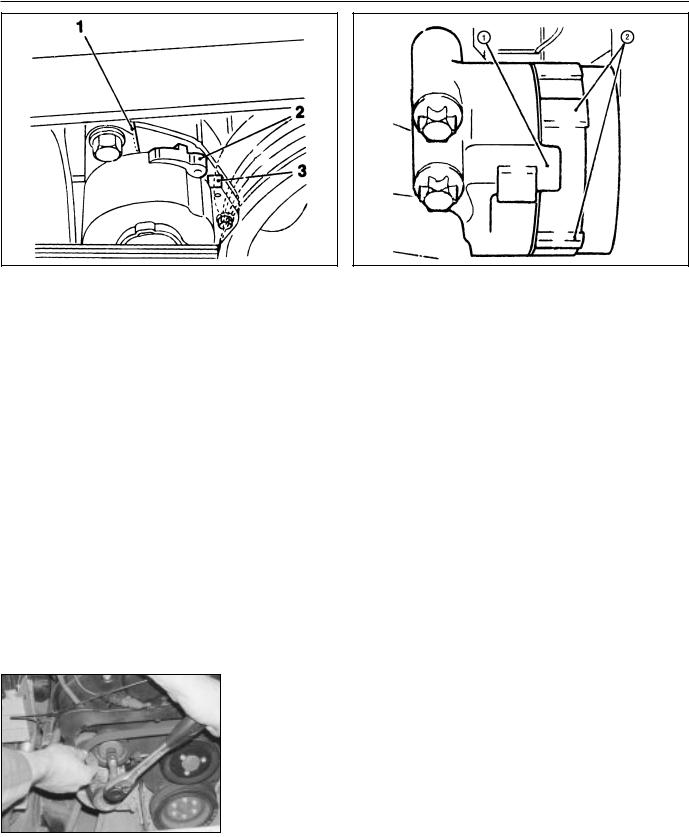
1•8 Every 10 000 miles
6.3a On 2.0 litre engines check that the drivebelt tensioner arm indicator (2) is correctly positioned between the stops (1 and 3) on the backplate
6.3b On 2.5 and 3.0 litre engines ensure the stop (1) on the drivebelt tensioner mounting plate is in between the lugs (2) on the arm
7Proceed as described in paragraphs 2 to 4 inclusive, noting that the inspection aperture is at the rear of the caliper.
8On completion, refit the rear roadwheels and lower the vehicle to the ground.
6 Auxiliary drivebelt - |
3 |
check and renewal |
|
|
|
Check
1 Although the drivebelt tension is automatically adjusted by the spring-loaded tensioner, the belt itself should still be regularly checked for damage or deterioration. 2 With the engine stopped, inspect the full length of the drivebelt for cracks and separation of the belt plies. It will be necessary to turn the engine (using a spanner or socket and bar on the crankshaft pulley bolt) in order to move the belt from the pulleys so that the belt can be inspected thoroughly. Twist the belt between the pulleys so that both sides can be viewed. Also check for fraying, and glazing which gives the belt a
6.12 Lever the tensioner away from the belt then slip the belt off from its pulleys (2.5 litre engine shown)
shiny appearance. Check the pulleys for nicks, cracks, distortion and corrosion.
3 Check the position of the drivebelt tensioner assembly arm in relation to the backplate. On 2.0 litre engines the arm indicator should be in between the stops on the backplate and should be free to move. On 2.5 and 3.0 litre engines the stop on the tensioner mounting plate should be positioned between the lugs on the arm and the arm should be free to move (see illustrations).
4 If the belt shows signs of wear or damage, or the tensioner arm is against the stop, the belt must be renewed.
Renewal
2.0 litre engine
5Prior to removal make a note of the correct routing of the belt around the various pulleys. If the belt is to be reused, also mark the direction of rotation on the belt to ensure the belt is refitted the same way around.
6Using a suitable spanner or socket fitted to the tensioner pulley centre bolt, lever the tensioner away from the belt until there is sufficient slack to enable the belt to be slipped off from the pulleys. Carefully release the tensioner pulley until it is against its stop then remove the belt from the vehicle. If necessary, the tensioner can be locked in the released position by aligning the arm hole with the hole in the backplate and inserting a suitable tool/pin.
7Manoeuvre the belt into position, routing it correctly around the pulleys; if the original belt is being fitted use the marks made prior to removal to ensure it is fitted the correct way around.
8Lever the tensioner roller back against is spring, and seat the belt on the pulleys. Ensure the belt is centrally located on all pulleys then slowly release the tensioner
pulley until the belt is correctly tensioned. Do not allow the tensioner to spring back and stress the belt.
9 Check the tensioner arm is correctly positioned in relation to the backplate (see paragraph 3).
2.5 and 3.0 litre engine
10Remove the multi-ram air intake system pre-volume chamber and the secondary air injection system front connecting pipe as described in the relevant Parts of Chapter 4.
11Prior to removal make a note of the correct routing of the belt around the various pulleys. If the belt is to be reused, also mark the direction of rotation on the belt to ensure the belt is refitted the same way around.
12Using a suitable spanner or socket fitted to the tensioner pulley centre bolt, lever the tensioner away from the belt until there is sufficient slack to enable the belt to be slipped off from the pulleys (see illustration). Carefully release the tensioner pulley until it is against its stop then remove the belt from the vehicle.
13Manoeuvre the belt into position, routing it correctly around the pulleys; if the original belt is being fitted use the marks made prior to removal to ensure it is fitted the correct way around.
14Lever the tensioner roller back against is spring, and seat the belt on the pulleys. Ensure the belt is centrally located on all pulleys then slowly release the tensioner pulley until the belt is correctly tensioned. Do not allow the tensioner to spring back and stress the belt.
15Check the tensioner arm is correctly positioned in relation to the backplate (see paragraph 3) then refit the secondary air injection system connecting pipe and the multi-ram air intake system pre-volume chamber as described in the relevant part of Chapter 4.
3510 Vauxhall/Opel Omega

Every 10 000 miles 1•9
7 Underbonnet/underbody |
2 |
hose and fluid leak - |
|
check |
Cooling system
Warning: Refer to the safety information given in Safety First and Chapter 3 before disturbing
any of the cooling system components.
1 Carefully check the radiator and heater coolant hoses along their entire length. Renew any hose which is cracked, swollen or which shows signs of deterioration. Cracks will show up better if the hose is squeezed. Pay close attention to the clips that secure the hoses to the cooling system components. Hose clips that have been over-tightened can pinch and puncture hoses, resulting in cooling system leaks (see illustration).
2 Inspect all the cooling system components (hoses, joint faces, etc) for leaks. Where any problems of this nature are found on system components, renew the component or gasket with reference to Chapter 3.
A leak in the cooling system |
will usually manifest itself as |
white or rust-coloured, |
crusty deposits on the area |
adjacent to the leak |
Inspect the petrol tank and filler neck for punctures, cracks and other damage. The connection between the filler neck and tank is especially critical. Sometimes a rubber filler neck or connecting hose will leak due to loose retaining clamps or deteriorated rubber.
6 Carefully check all rubber hoses and metal fuel lines leading away from the petrol tank. Check for loose connections, deteriorated hoses, kinked lines, and other damage. Pay particular attention to the vent pipes and hoses, which often loop up around the filler neck and can become blocked or kinked, making tank filling difficult. Follow the fuel supply and return lines to the front of the vehicle, carefully inspecting them all the way for signs of damage or corrosion. Renew damaged sections as necessary.
Engine oil
7 Inspect the area around the camshaft cover, cylinder head, oil filter and sump joint faces. Bear in mind that, over a period of time, some very slight seepage from these areas is to be expected - what you are really looking for is any indication of a serious leak caused by gasket failure. Engine oil seeping from the base of the timing belt cover or the transmission bellhousing may be an indication of crankshaft or transmission input shaft oil seal failure. Should a leak be found, renew the failed gasket or oil seal by referring to the appropriate Chapters in this manual.
Automatic transmission fluid
8 Check the hoses leading to the transmission fluid cooler for leakage. Look for deterioration caused by corrosion and damage from grounding, or debris thrown up from the road surface. Automatic transmission fluid is a thin oil and is usually red in colour. Check the area around the propeller shaft seal at the rear of the transmission for signs of fluid leakage. Should a leak be found, check the fluid level as described in Section 19 then rectify the cause of leakage as soon as possible.
Power assisted steering (PAS) fluid
9Examine the hose running between the fluid reservoir and the power steering pump, and the return hose running from the steering rack to the fluid reservoir. Also examine the high pressure supply hose between the pump and the steering rack.
10Check the condition of each hose carefully. Look for deterioration caused by corrosion and damage from grounding, or debris thrown up from the road surface.
11Pay particular attention to crimped unions, and the area surrounding the hoses that are secured with adjustable worm drive clips. Like automatic transmission fluid, PAS fluid is a thin oil, and is usually red or light brown in colour.
1
Fuel system
Warning: Refer to the safety information given in Safety First and Chapter 4A before disturbing
any of the fuel system components.
3 Petrol leaks can be difficult to pinpoint, unless the leakage is significant and hence easily visible. Fuel tends to evaporate quickly once it comes into contact with air, especially in a hot engine bay. Small drips can disappear before you get a chance to identify the point of leakage. If you suspect that there is a fuel leak from the area of the engine bay, leave the vehicle overnight then start the engine from cold, with the bonnet open. Metal components tend to shrink when they are cold, and rubber seals and hoses tend to harden, so any leaks will be more apparent whilst the engine is warming up from a cold start.
4Check all fuel lines at their connections to the fuel rail, fuel pressure regulator and fuel filter (petrol models), Examine each rubber fuel hose along its length for splits or cracks. Check for leakage from the crimped joints between rubber and metal fuel lines. Examine the unions between the metal fuel lines and the fuel filter housing. Also check the area around the fuel injectors for signs of O-ring leakage.
5To identify fuel leaks between the fuel tank and the engine bay, the vehicle should raised
and securely supported on axle stands. |
7.1 Possible causes of coolant hose failure |
3510 Vauxhall/Opel Omega
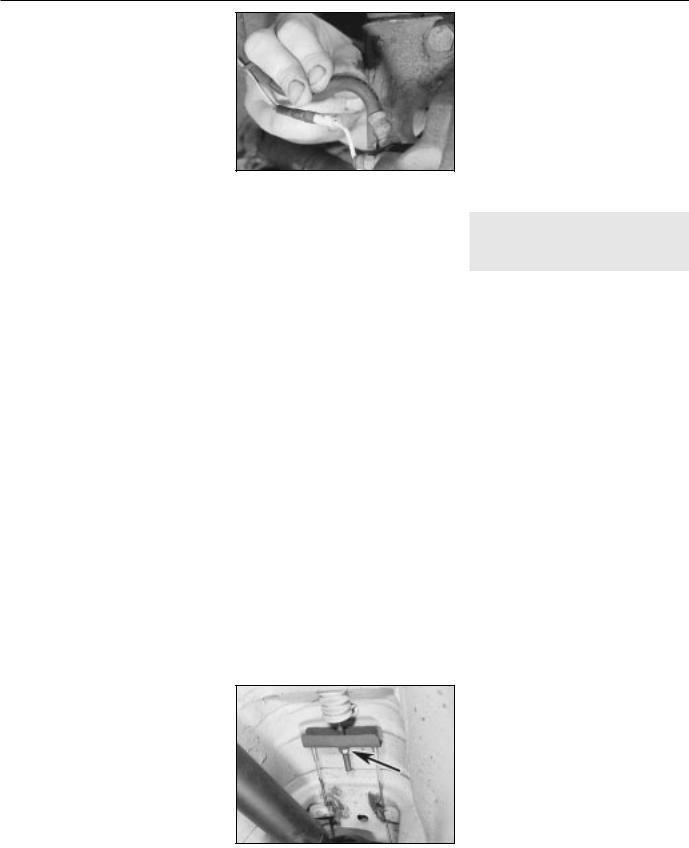
1•10 Every 10 000 miles
Air conditioning refrigerant
Warning: Refer to the safety information given in Safety First and Chapter 3, regarding the
dangers of disturbing any of the air conditioning system components.
12The air conditioning system is filled with a liquid refrigerant, which is retained under high pressure. If the air conditioning system is opened and depressurised without the aid of specialised equipment, the refrigerant will immediately turn into gas and escape into the atmosphere. If the liquid comes into contact with your skin, it can cause severe frostbite. In addition, the refrigerant contains substances which are environmentally damaging; for this reason, it should not be allowed to escape into the atmosphere in an uncontrolled fashion.
13Any suspected air conditioning system leaks should be immediately referred to a Vauxhall dealer or air conditioning specialist. Leakage will be shown up as a steady drop in the level of refrigerant in the system.
14Note that water may drip from the condenser drain pipe, underneath the car, immediately after the air conditioning system has been in use. This is normal, and should not be cause for concern.
Brake fluid
Warning: Refer to the safety information given in Safety First and Chapter 9, regarding the
dangers of handling brake fluid.
15Examine the area surrounding the brake pipe unions at the master cylinder for signs of leakage. Check the area around the base of fluid reservoir, for signs of leakage caused by seal failure. Also examine the brake pipe unions at the ABS hydraulic unit.
16If fluid loss is evident, but the leak cannot be pinpointed in the engine bay, the brake calipers and underbody brake lines should be carefully checked with the vehicle raised and supported on axle stands (see illustration). Leakage of fluid from the braking system is a serious fault that must be rectified immediately.
17Brake/clutch hydraulic fluid is a toxic substance with a watery consistency. New fluid is almost colourless, but it becomes darker with age and use.
7.16 Inspecting the flexible hose connection to a front brake caliper
leakage. Should a leak be found, check the differential fluid level as described in Chapter 8 then rectify the cause of leakage as soon as possible.
Unidentified fluid leaks
20 If there are signs that a fluid of some description is leaking from the vehicle, but you cannot identify the type of fluid or its exact origin, park the vehicle overnight and slide a large piece of card underneath it. Providing that the card is positioned in roughly the right location, even the smallest leak will show up on the card. Not only will this help you to pinpoint the exact location of the leak, it should be easier to identify the fluid from its colour. Bear in mind, though, that the leak may only be occurring when the engine is running!
Vacuum hoses
21 Although the braking system is hydraulically-operated, the brake servo unit amplifies the effort applied at the brake pedal, by making use of the vacuum in the inlet manifold, generated by the engine. Vacuum is ported to the servo by means of a large-bore hose. Any leaks that develop in this hose will reduce the effectiveness of the braking system, and may affect the running of the engine.
22 In addition, a number of the underbonnet components, particularly the emission control components, are driven by vacuum supplied from the inlet manifold via narrow-bore rubber
Manual transmission fluid |
|
18 Check the area around the propeller shaft |
|
seal at the rear of the transmission for signs of |
|
fluid leakage. Should a leak be found, check |
|
the transmission fluid level as described in |
|
Chapter 7A then rectify the cause of leakage |
|
as soon as possible. |
|
Final drive unit differential fluid |
|
19 Check the area around the driveshaft and |
9.5 Handbrake cable adjustment nut |
propeller shaft seals, and the flange seal on |
|
the rear of the final drive unit for signs of fluid |
(arrowed) |
and plastic hoses. A leak in a vacuum hose means that air is being drawn into the hose (rather than escaping from it) and this makes leakage very difficult to detect. One method is to use an old length of vacuum hose as a kind of stethoscope - hold one end close to (but not in!) your ear and use the other end to probe the area around the suspected leak. When the end of the hose is directly over a vacuum leak, a hissing sound will be heard clearly through the hose. Care must be taken to avoid contacting hot or moving components, as the engine must be running, when testing in this manner. Renew any vacuum hoses that are found to be defective.
8 Bodywork/underbody |
5 |
corrosion protection - |
|
check |
1 This work should be carried out by a Vauxhall/Opel dealer in order to validate the vehicle warranty. The work includes a thorough inspection of the vehicle paintwork and underbody for damage and corrosion
9 Handbrake operation - |
2 |
check and adjustment |
|
|
|
1Chock the front wheels, then jack up the rear of the vehicle and support it securely on axle stands (see Jacking and Vehicle Support). Remove the rear roadwheels.
2Fully release the handbrake lever, then apply it to the third notch. Check that both rear wheels can still rotate by attempting to turn them by hand (ensure that the transmission is in neutral). Release the handbrake lever.
3Fully apply the handbrake lever, so that the rear wheels are locked, counting how many notches the lever passes through. If the handbrake lever passes through more than seven notches before the rear wheels lock, adjustment is required.
4If adjustment is necessary, first fully release the handbrake, then pull it up to the third notch.
5Working underneath the vehicle, unbolt the exhaust system heat shields from the floorpan. Locate the handbrake cable adjustment nut, at the cable compensation bar, above the propeller shaft. Fully slacken the adjustment nut so that there is a small amount of clearance between it and the compensation bar (see illustration).
6Working on one brake disc at a time, position the hole in the disc over the serrated adjustment nut on the adjuster at the top of the backplate. Using a screwdriver inserted through the hole, turn the nut until the brake disc locks, then turn the nut in opposite direction until the disc is just free (see illustration). Repeat the adjustment on the remaining rear brake.
3510 Vauxhall/Opel Omega
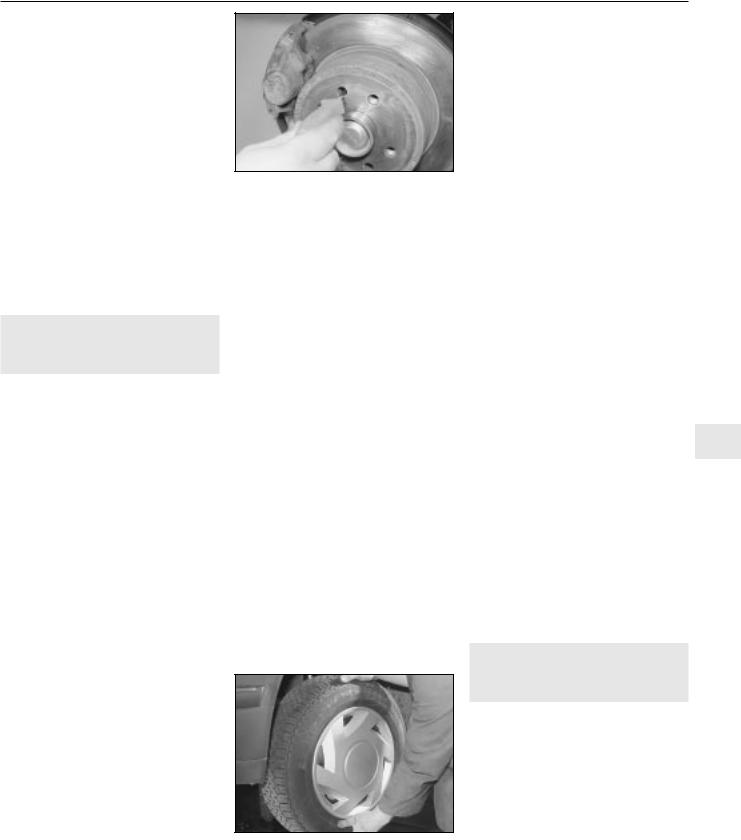
Every 10 000 miles 1•11
7 Check that the handbrake lever is still positioned on the third notch, then working underneath the vehicle, tighten the handbrake cable adjustment nut against the compensation bar, until the handbrake shoes just start to take effect - test for this by turning the brake discs by hand.
8Refit the rear wheels, then carry out a final check of the handbrake adjustment; the rear wheels should turn freely with the lever applied to the third notch and should be fully locked before passing through the seventh notch. Tighten the wheel bolts to the specified torque then lower the car the ground. Check the operation of the handbrake before using the vehicle on the road.
9After fitting new handbrake shoes, the shoes should be bedded-in by driving a short distance (approximately 300 metres) at low speed with the handbrake lever lightly applied. Check, and if necessary adjust the handbrake again after completing the bedding-in.
10 Suspension and steering |
2 |
condition and operation - |
|
check |
Front suspension and steering check
1Raise the front of the vehicle, and securely support it on axle stands (see Jacking and Vehicle Support).
2Visually inspect the balljoint dust covers and the steering rack-and-pinion gaiters for splits, chafing or deterioration. Any wear of these components will cause loss of lubricant, together with dirt and water entry, resulting in rapid deterioration of the balljoints or steering gear.
3Check the power steering fluid hoses for chafing or deterioration, and the pipe and hose unions for fluid leaks. Also check for signs of fluid leakage under pressure from the steering gear rubber gaiters, which would indicate failed fluid seals within the steering gear.
4Grasp the roadwheel at the 12 o’clock and
6o’clock positions, and try to rock it (see illustration). Very slight free play may be felt, but if the movement is appreciable, further investigation is necessary to determine the source. Continue rocking the wheel while an assistant depresses the footbrake. If the movement is now eliminated or significantly reduced, it is likely that the hub bearings are at fault. If the free play is still evident with the footbrake depressed, then there is wear in the suspension joints or mountings.
5Now grasp the wheel at the 9 o’clock and 3 o’clock positions, and try to rock it as before. Any movement felt now may again be caused by wear in the hub bearings or the steering track-rod balljoints. If the outer balljoint is worn, the visual movement will be obvious. If the inner joint is suspect, it can be felt by
9.6 Adjusting the handbrake screws using a screwdriver through the hole in the disc/hub flange
placing a hand over the rack-and-pinion rubber gaiter and gripping the track-rod. If the wheel is now rocked, movement will be felt at the inner joint if wear has taken place.
6Using a large screwdriver or flat bar, check for wear in the suspension mounting bushes by levering between the relevant suspension component and its attachment point. Some movement is to be expected, as the mountings are made of rubber, but excessive wear should be obvious. Also check the condition of any visible rubber bushes, looking for splits, cracks or contamination of the rubber.
7With the car standing on its wheels, have an assistant turn the steering wheel back-and- forth, about an eighth of a turn each way. There should be very little, if any, lost movement between the steering wheel and roadwheels. If this is not the case, closely observe the joints and mountings previously described. In addition, check the steering column universal joints for wear, and also check the rack-and-pinion steering gear itself.
Rear suspension check
8Chock the front wheels, then jack up the rear of the vehicle and support securely on axle stands (see Jacking and Vehicle Support).
9Working as described previously for the front suspension, check the rear hub bearings, the suspension bushes and the strut or shock absorber mountings (as applicable) for wear.
10.4 To check for play in the wheel bearing, grasp the roadwheel at the 12 o’clock and 6 o’clock positions, and try to rock it
Shock absorber check
10 Check for any signs of fluid leakage around the shock absorber body, or from the rubber gaiter around the piston rod. Should any fluid be noticed, the shock absorber is defective internally, and should be renewed.
Note: Shock absorbers should always be renewed in pairs on the same axle.
11 The efficiency of the shock absorber may be checked by bouncing the vehicle at each corner. Generally speaking, the body will return to its normal position and stop after being depressed. If it rises and returns on a rebound, the shock absorber is probably suspect. Also examine the shock absorber upper and lower mountings for any signs of wear.
11 Wheel bolt torque - |
2 |
|
check and adjustment |
||
|
||
|
|
Note: As well as being potentially damaging to the vehicle’s roadwheels, over-tightened wheel bolts may cause problems if you have to change a wheel by the side of the road. By ensuring that the wheel bolts are tightened to the correct torque, you could save yourself a lot of time and trouble in an emergency situation.
1 Slacken the front wheel securing bolts slightly, then apply the handbrake firmly, raise
the front of the vehicle, and securely support 1 it on axle stands (see Jacking and Vehicle Support).
2Fully slacken the each of the wheel bolts in turn and clear any dirt of debris from the threads. Re-insert the wheel bolts and tighten them to the specified torque setting using a good quality torque wrench.
3Repeat the operation at the opposite wheel, then lower the car the ground.
4Chock the front wheels, then jack up the rear of the vehicle and support securely on axle stands (see Jacking and Vehicle Support). Repeat the operations described in paragraphs 2 and 3.
12 Headlight and auxiliary |
5 |
driving light beam alignment |
|
- check |
1Badly adjusted headlights and/or foglights cause poor visibility and can dazzle other road users. Accurate adjustment of the headlight and auxiliary driving light beams is only possible using optical beam-setting equipment, and this work should therefore be carried out by a Vauxhall/Opel dealer or suitably-equipped workshop.
2For reference, the headlights can be adjusted using the adjuster assemblies fitted to the front upper outer mounting and to the rear inner mounting. The inner screw is for horizontal adjustment and the outer one for
3510 Vauxhall/Opel Omega
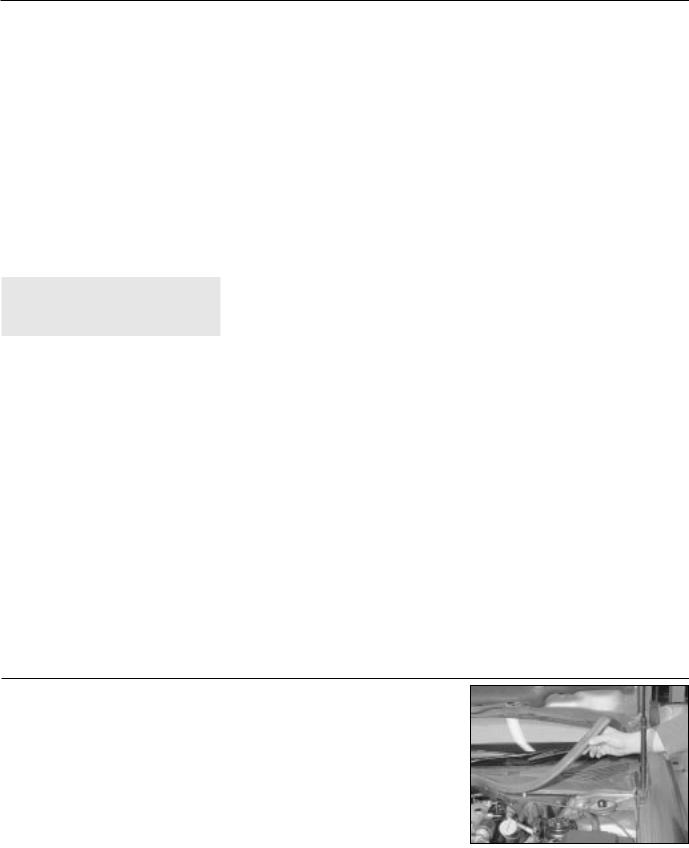
1•12 Every 10 000 miles
vertical adjustment. When adjusting the headlight aim, ensure that the facia -mounted range adjustment switch is set to position 0 (see paragraph 3).
3 All models have an electric headlight beam adjustment range system, controlled via a rotary switch in the facia*. The recommended settings are as follows.
0Front seat(s) occupied
1All seats occupied
2All seats occupied, and load in luggage compartment
3Driver’s seat occupied and load in the luggage compartment
*On models built from 1998 onwards with Xenon headlights, an automatic headlamp range adjustment system is fitted, to which no manual adjustment can be made; see Chapter 12 for details.
13 Road test |
1 |
|
Instruments and electrical equipment
1Check the operation of all instruments and electrical equipment.
2Make sure that all instruments read correctly, and switch on all electrical equipment in turn, to check that it functions properly.
Steering and suspension
3Check for any abnormalities in the steering, suspension, handling or road feel.
4Drive the vehicle, and check that there are no unusual vibrations or noises.
5Check that the steering feels positive, with no excessive sloppiness, or roughness, and check for any suspension noises when cornering and driving over bumps.
Drivetrain
6 Check the performance of the engine, clutch, transmission and driveshafts.
7 Listen for any unusual noises from the engine, clutch and transmission.
8Make sure that the engine runs smoothly when idling, and that there is no hesitation when accelerating.
9Check that, where applicable, the clutch action is smooth and progressive, that the drive is taken up smoothly, and that the pedal travel is not excessive. Also listen for any noises when the clutch pedal is depressed.
10Check that all gears can be engaged smoothly without noise, and that the gear lever action is not abnormally vague or notchy.
11On automatic transmission models, make sure that all gearchanges occur smoothly, without snatching, and without an increase in engine speed between changes. Check that all of the gear positions can be selected with the vehicle at rest. If any problems are found, they should be referred to a Vauxhall/Opel dealer.
Check the operation and performance of the braking system
12Make sure that the vehicle does not pull to one side when braking, and that the wheels do not lock prematurely when braking hard.
13Check that there is no vibration through the steering when braking.
14Check that the handbrake operates correctly, without excessive movement of the lever, and that it holds the vehicle stationary on a slope.
15Test the operation of the brake servo unit as follows. Depress the footbrake four or five times to exhaust the vacuum, then start the engine. As the engine starts, there should be a noticeable give in the brake pedal as vacuum builds up. Allow the engine to run for at least two minutes, and then switch it off. If the brake pedal is now depressed again, it should be possible to detect a hiss from the servo as the pedal is depressed. After about four or five applications, no further hissing should be heard, and the pedal should feel considerably harder.
14 Wheel alignment - |
5 |
check |
|
|
|
1Accurate wheel alignment is essential for positive, accurate steering, stable road holding and to prevent abnormal tyre wear. Wheel alignment checking is carried out with the car loaded to its kerbside weight, and with the tyre pressures correctly adjusted.
2The front toe setting, front camber angle, rear toe setting and rear camber angle are all adjustable, but can only be checked using specialised equipment; work of this nature should therefore be entrusted to a garage or suitably-equipped tyre specialist.
15 Exhaust system - |
2 |
check |
|
|
|
1 Park the vehicle on a level surface and switch off the engine. Chock the front wheels, then raise the rear of the vehicle and support it securely on axle stands - refer to Jacking and vehicle support in Reference.
2With the engine cold (wait at least an hour after switching off the engine), check the complete exhaust system from the engine to the end of the tailpipe.
3Check the exhaust pipes and connections for evidence of leaks, severe corrosion and damage. Make sure that all brackets and mountings are in good condition, and that all relevant nuts and bolts are tight. Leakage at any of the joints or in other parts of the system will usually show up as a black, sooty stain in the vicinity of the leak.
4Rattles and vibrations can often be traced to the exhaust system. Tap the silencer units with a soft mallet and listen for noises caused by corroded or displaced baffle material. Do not strike the catalytic converter, as this may damage the ceramic block inside.
5Carefully rock the pipes and silencers from side to side on their mountings. If the components are able to come into contact with the body or suspension parts, look for broken or worn rubber mountings.
Every 20 000 miles or 2 years
16 Air filter element - |
1 |
renewal |
|
|
|
1The air cleaner is located in the front righthand corner of the engine compartment.
2Release the retaining clip and disconnect the intake duct from the air cleaner housing.
3Release the retaining clips then lift the air cleaner cover and filter element out of position.
4Wipe out the casing and the cover.
5Fit the new filter, noting that the rubber locating flange should be uppermost, and secure the cover with the clips.
6 Reconnect the intake duct to the air cleaner housing and secure it in position with the retaining clip.
17 Pollen filter - |
2 |
|
renewal |
||
|
||
|
|
1 Open the bonnet and support it in the upright position.
2 Carefully peel the rubber beading away from the bulkhead seam, at the rear of the engine compartment, on the drivers side of the car (see illustration).
17.2 Carefully peel the rubber beading away from the bulkhead seam
3510 Vauxhall/Opel Omega
